



HomePage Naša putovanja Nostri viaggi Unsere Reisen Our travels
Introduction Norway 2002 Norway 2004
Photo album 2002 Photo album 2004
Skandinavija 1995 Skandinavien 1995 Scandinavia (I) 1995




DIARY OF OUR FIRST VISIT TO SCANDINAVIA IN 1995
Denmark - Norway - Finland - Sweden
05.06. - 25.07.1995
Recorded: Stojan Deprato
English translation: Branko Ryšlavý
Click on the map or the photo to enlarge!
The 1st Day – date 05.06.1995 - Monday: San Maurizio (I) - Kappel (CH) – 430 km
The two of us, my spouse Carla and I (68), we
departed with our camper from San Maurizio
Canavese on
a long trip towards the far North, towards the Scandinavia, at 2.30 p.m. on the
quoted day. Our camper is
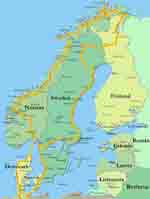 of
the Dethleffs Globetrotter make, type A532 of 1991 on the Fiat Ducato chassis,
having the overall measures
LxBxH 562x223x283
cm and provided with the Fiat engine TD95 of 2.482 cubic centimetres, rated for
70 kW (95 HP).
of
the Dethleffs Globetrotter make, type A532 of 1991 on the Fiat Ducato chassis,
having the overall measures
LxBxH 562x223x283
cm and provided with the Fiat engine TD95 of 2.482 cubic centimetres, rated for
70 kW (95 HP).
All localities, islands, fiords and similar, whose denominations are printed in this diary in red, can be found in enclosed maps. Regrettably, we have had only the VHS film camera, not a digital photo camera (as the case was in the year 2002 and later), so that we were not able to enclose the photos from this trip.
It was drizzling. Fifteen minutes ago a strong rain was falling accompanied by thundering. Some last ten days we have had here plenty of rain and it is rather cold. But, according to the news, it was hot and damp in Moscow!? Let us hope that we will have a nicer and warmer weather in the north nevertheless.
In places Leinì and Chivasso, (some ten km from San Maurizio), the grass and the ground around the road were covered by ice. It meant that, along with the thundering that we heard at home, the hail fell here. The ice layer was about 3 cm thick. Onwards, towards Milan and all to the Swiss border (Chiasso), the rain was accompanying us.
We entered Switzerland and
the sun appeared among the clouds. We continued for
San Gotthard and the weather was
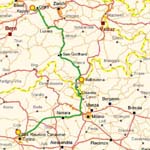 getting
nicer and nicer, less cloudy and with more and more sun. We were listening to
the radio news about the slow-down in front of the San Gotthard Tunnel with a
line of cars some 3 km long. We were even lucky to some degree, since, according
to the radio news, the queue in front of the San Bernardino is 17 km long! It
was Whitsunday’s Monday and the Swiss and Germans were getting back from Italy
after a long weekend. It was a rainy, not a sunny one. When we reached the
tunnel, the line was
getting
nicer and nicer, less cloudy and with more and more sun. We were listening to
the radio news about the slow-down in front of the San Gotthard Tunnel with a
line of cars some 3 km long. We were even lucky to some degree, since, according
to the radio news, the queue in front of the San Bernardino is 17 km long! It
was Whitsunday’s Monday and the Swiss and Germans were getting back from Italy
after a long weekend. It was a rainy, not a sunny one. When we reached the
tunnel, the line was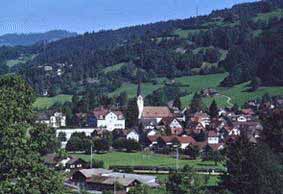 just only 200 -300 m long, with cars in two queuing lines and two traffic lights
operating. Lucky we! We
had waited for two minutes only and our queuing
line got the green light: move on into the tunnel! We found rain
again on the northern side of
the tunnel which had accompanied us on our trip through
Luzern and all up to
Kappel
(FOTO). We reached Kappel at 8.30 p.m.
and got settled at the place of Davor, our son, which is living there with his
family. I brought my PC to Davor for inspection and repair, since it appeared to
have some problems with the memory. We parked in front of their house and after
the dinner we went to bed in our camper at 11.30 p.m. The parking place was
super quiet and the night was fresh, as if created for resting.
just only 200 -300 m long, with cars in two queuing lines and two traffic lights
operating. Lucky we! We
had waited for two minutes only and our queuing
line got the green light: move on into the tunnel! We found rain
again on the northern side of
the tunnel which had accompanied us on our trip through
Luzern and all up to
Kappel
(FOTO). We reached Kappel at 8.30 p.m.
and got settled at the place of Davor, our son, which is living there with his
family. I brought my PC to Davor for inspection and repair, since it appeared to
have some problems with the memory. We parked in front of their house and after
the dinner we went to bed in our camper at 11.30 p.m. The parking place was
super quiet and the night was fresh, as if created for resting.
The 2nd Day – 06.06.1995 - Tuesday: Kappel (CH) - Kempten (D) – 291/721 km
We
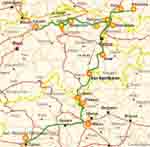 got
up at 7.00 a.m. and had breakfast with Davor, who went to his work after this.
At 8.30 a.m. we left Kappel for
Zürich. The weather was cloudy and after
few kilometres the rain started. We drove by the motorway which lead us,
bypassing Zurich and Winterthur to St.
Gallen.
From St.Gallen we were supposed to deviate for
Bregenz, but we did notice the way out from the Swiss motorway only
after having passed it. We had to continue on towards the south all up to the
way out for Diepoldsau. We left the
motorway there, to bunker the diesel fuel, which was at its minimum already.
There was not a trace of a gas station on the motor way! After having finally
found and bunkered the diesel fuel, we returned back to the Austrian motorway,
passed through Bregenz and entered Germany, went through
Isny and, with rain that had accompanied
us the whole way, arrived at 2.30 p.m. in
Kempten, to Carla’s parents. They dwell on a smaller hill, a bit out
from the town’s centre. We parked on their parking site in front of the house.
The night, like in Kappel again, was quiet and peaceful for sleeping, but very
fresh, chilly.
got
up at 7.00 a.m. and had breakfast with Davor, who went to his work after this.
At 8.30 a.m. we left Kappel for
Zürich. The weather was cloudy and after
few kilometres the rain started. We drove by the motorway which lead us,
bypassing Zurich and Winterthur to St.
Gallen.
From St.Gallen we were supposed to deviate for
Bregenz, but we did notice the way out from the Swiss motorway only
after having passed it. We had to continue on towards the south all up to the
way out for Diepoldsau. We left the
motorway there, to bunker the diesel fuel, which was at its minimum already.
There was not a trace of a gas station on the motor way! After having finally
found and bunkered the diesel fuel, we returned back to the Austrian motorway,
passed through Bregenz and entered Germany, went through
Isny and, with rain that had accompanied
us the whole way, arrived at 2.30 p.m. in
Kempten, to Carla’s parents. They dwell on a smaller hill, a bit out
from the town’s centre. We parked on their parking site in front of the house.
The night, like in Kappel again, was quiet and peaceful for sleeping, but very
fresh, chilly.
The 3rd Day – 07.06.1995 -Wednesday: Kempten – 0/721 km
We
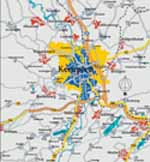 spent
the whole day at Carla’s parents in Kempten
(FOTO).
Kempten is a small town in Bavaria, very beautiful,
spent
the whole day at Carla’s parents in Kempten
(FOTO).
Kempten is a small town in Bavaria, very beautiful,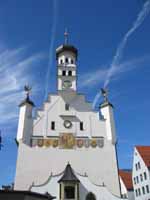 located among the hills and all in greenery. Along the main roads or in the
natural surroundings there are many tracks or paths reserved for cyclists. You
can ride the bicycle everywhere with no danger from cars. There are as well
quite numerous ways for the walks through the nature, wood or around a lake. In
the town and outside it every while great panels are encountered which feature
all possible maps of paths (numbered), which enable to circulate through the
town or around it on foot or by bicycle.
located among the hills and all in greenery. Along the main roads or in the
natural surroundings there are many tracks or paths reserved for cyclists. You
can ride the bicycle everywhere with no danger from cars. There are as well
quite numerous ways for the walks through the nature, wood or around a lake. In
the town and outside it every while great panels are encountered which feature
all possible maps of paths (numbered), which enable to circulate through the
town or around it on foot or by bicycle.
We went to the warehouse in the morning and bought a great quantity of tinned food (Feuerbohnensuppe, Huhnersuppe, Gulaschsuppe*), then sausages, pâtés, soaps, Badedas, sandals, t-shirts and various other silly items.
The sun finally appeared in the afternoon and the climate became right away more pleasant. Carla’s father didn’t feel quite well that afternoon. Carla went with her mother for a shorter walk.
Sleeping was again in the camper on the parking site in front of the house. It was quiet and pleasant.
*) Hot dry bean soup, chicken soup, goulash soup
The 4th Day – 08.06.1995 - Thursday: Kempten (D) - Birkenau-N.L. (D) – 363/1.084 km
We awoke with nice weather,
said good bye to Carla’s parents, descended to Kempten and parked for half an
hour at the railway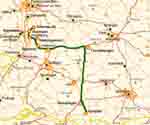 station because of some additional shopping. Upon that we started north by the
motorway and bypassed Memmingen,
Ulm,
Feuchtwangen and Heilbronn.
On our way we went through several storms, however, the ride on the motorway was
without the slowdowns. We left the motorway at the place called
Sinsheim and passing through
Neckargemünd,
Heidelberg and
Weinheim reached the
Birkenau-N.L., some 100 km south of
Frankfurt at 6.00 p.m. at nice weather.
station because of some additional shopping. Upon that we started north by the
motorway and bypassed Memmingen,
Ulm,
Feuchtwangen and Heilbronn.
On our way we went through several storms, however, the ride on the motorway was
without the slowdowns. We left the motorway at the place called
Sinsheim and passing through
Neckargemünd,
Heidelberg and
Weinheim reached the
Birkenau-N.L., some 100 km south of
Frankfurt at 6.00 p.m. at nice weather.
There, in Birkenau - N.L., just outside the town and at some 200m from the asphalted road, dwell Ulla and Herbert, our old friends form the camp in Medulin, in Istria. They have got a nice small house on the steep little hill, whereas one enters their courtyard from the white road, ending just in front of their house (VIDEO 1). By a narrow way, over small hairpin windings among pine trees, over the ground covered with wonderful ivy, one comes to the terrace in front of the house. The house is also surrounded by pine trees, from which the squirrels come to terrace and take walnuts from hand. Very romantic, far from the traffic, noise, people, shops and civilisation, there is only the radio and television. We had parked and slept overnight on the small road in front of the house. Very quiet, the moos of some cow could be heard here and there. Quite pastoral!?
The 5th Day – 09.06.1995 - Friday: Birkenau-N.L. (D) – Steinberg – Braunschweig (D) – 486/1.570 km
Herbert had left for his job in the morning
and we left with Ulla at 9.00 a.m. for a warehouse at Mannheim selling garden
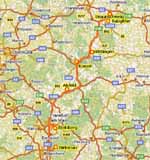 equipment.
We wanted to buy a gazebo, such one we saw in Ulla’s garden, for our camp in
Medulin, but all of them were sold out. Were to be supplied next week only! We
left to Ulla the money to buy two of them, (one for Davor), and we would pick
them on our return trip.
equipment.
We wanted to buy a gazebo, such one we saw in Ulla’s garden, for our camp in
Medulin, but all of them were sold out. Were to be supplied next week only! We
left to Ulla the money to buy two of them, (one for Davor), and we would pick
them on our return trip.
We took our leave of Ulla
and Herbert, who had arrived in the meantime from the warehouse, and departed
with a nice weather towards the north again. We arrived at 10.50 a.m. in
Steinberg (Dietzenbach, at the outskirt
of Frankfurt), where Carla’s uncle
and aunt (Werner and Ursula) are dwelling. After lunch and chatting we started
at 1.30 p.m. further to the north. We passed by the motor way west from Frankfurt and then close to Alsfeld,
Kassel,
Göttingen and
Salzgitter.
west from Frankfurt and then close to Alsfeld,
Kassel,
Göttingen and
Salzgitter.
About 6.50 p.m. we reached the outskirts of Braunschweig (FOTO), where Hajo and Brigitte, old friends from the Medulin camp, too, were waiting for us. The weather from Steinberg to Braunschweig was mixed: a little sun, then rain, then sun, then clouds and then all this to be repeated again. Hajo and Brigitte have got a very nice house. After dinner we continued with chatting till midnight, and then we packed ourselves into our camper parked in the courtyard and had a good night sleep in a pleasant silence.
The 6th Day – 10.06.1995 - Saturday: Braunschweig (D) - Pinneberg (D) – 216/1.786 km
We did not hurry in the
morning. A long trip was not ahead of us, therefore we had plenty of time for t he
breakfast, showering and chatting, so, in addition, I went by bicycle, with Hajo
to a warehouse to buy some cartons of long life milk for the trip. At last, at
11.00 a.m., we started towards the north, but this time not by the motorway. We
had plenty of time and therefore we started by the road bypassing
Gifhorn, went through
Uelzen and round Lüneburg towards
Hamburg. The weather on the trip was so, so.
he
breakfast, showering and chatting, so, in addition, I went by bicycle, with Hajo
to a warehouse to buy some cartons of long life milk for the trip. At last, at
11.00 a.m., we started towards the north, but this time not by the motorway. We
had plenty of time and therefore we started by the road bypassing
Gifhorn, went through
Uelzen and round Lüneburg towards
Hamburg. The weather on the trip was so, so.
Before Hamburg we went through the tunnel under the river Elbe, then by the motorway partly through Hamburg and at 3 p.m. we were at Waldemar and Rotraut’s place, Carla’s cousin in Pinneberg (VIDEO 2). The daughter Natascha and son Konstantin were present. We had intended to continue our trip on towards the north, but Waldemar and Rotraut did not agree. We had to stay for dinner and a chat. We had parked our camper at the very entrance door, so it was not far to go to bed. The parking site was very quiet.
The 7th Day – 11.06.1995 . Sunday: Pinneberg (D)-Hvidbjerg (DK) – 471/2.257 km
We made a phone call to our
neighbour Luigi in San Maurizio in the morning. Everything OK at home, bu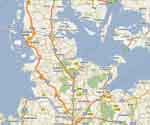 t
every day they were having two smaller tempests. We had, where we were, a better
and nicer weather so far. Let’s hope it would continue so! We departed towards
north at 19.15 a.m. and via Itzehoe,
Heide and Husum
reached the North Sea coast between the places
Bredstedt and Dagebüll. It was a
windy but sunny weather. All around there are everywhere many windmills for
generating electric
t
every day they were having two smaller tempests. We had, where we were, a better
and nicer weather so far. Let’s hope it would continue so! We departed towards
north at 19.15 a.m. and via Itzehoe,
Heide and Husum
reached the North Sea coast between the places
Bredstedt and Dagebüll. It was a
windy but sunny weather. All around there are everywhere many windmills for
generating electric
 energy.
Two or three huge wind blades were revolving on the 20-30 m high white and
elegant posts. Often
one could see some ten or more windmills in line, very close one to another.
Considering that the top part of the windmill (the one containing the blades) is
movable and ever facing the wind direction, the windmills can be seen as being
in line one after the other, or as being one next to the other. However, always
beautiful and imposing they are. Quiet and ecologically OK! But the green ones
are rebelling and want to remove them since, allegedly, they disturb the nature.
The power stations on coal or oil fuel would be better!? The silly ones! We
continued from there through Niebüll and
Süderlügum up to the Danish border.
energy.
Two or three huge wind blades were revolving on the 20-30 m high white and
elegant posts. Often
one could see some ten or more windmills in line, very close one to another.
Considering that the top part of the windmill (the one containing the blades) is
movable and ever facing the wind direction, the windmills can be seen as being
in line one after the other, or as being one next to the other. However, always
beautiful and imposing they are. Quiet and ecologically OK! But the green ones
are rebelling and want to remove them since, allegedly, they disturb the nature.
The power stations on coal or oil fuel would be better!? The silly ones! We
continued from there through Niebüll and
Süderlügum up to the Danish border.
Crossin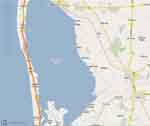 g
the border was without any problems. The border police did not even look at us.
We stopped at the parking lot
beyond the very border and Carla prepared an
express lunch: the hot dry bean soup (tinned German Feuerbohnensuppe).
Excellent! We heaved up the anchor at 4.00 p.m. and continued over the road 11
across Tønder and
Ribe to Varde, deviating there to
the road 181 towards the dunes. The sea cannot be seen because
of high dunes, but yes, many bungalows for renting to the tourists only. But
with the grey dunes and colourless bungalows all is leaving an impression of
some miners’ settlement in German Ruhrgebiet. And even in the sunny weather
today! How then is it looking in rain?
g
the border was without any problems. The border police did not even look at us.
We stopped at the parking lot
beyond the very border and Carla prepared an
express lunch: the hot dry bean soup (tinned German Feuerbohnensuppe).
Excellent! We heaved up the anchor at 4.00 p.m. and continued over the road 11
across Tønder and
Ribe to Varde, deviating there to
the road 181 towards the dunes. The sea cannot be seen because
of high dunes, but yes, many bungalows for renting to the tourists only. But
with the grey dunes and colourless bungalows all is leaving an impression of
some miners’ settlement in German Ruhrgebiet. And even in the sunny weather
today! How then is it looking in rain?
In
Hvide Sande we visited the picturesque fishing harbour
(VIDEO 4). People were
fishing from the quay, a multitude of seagulls in air and on the quay wall,
everywhere small fishing boats with variegated signals arranged on
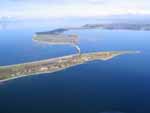 deck, which
serve to mark positions of the thrown nets or trawl lines.
deck, which
serve to mark positions of the thrown nets or trawl lines.
We continued then over 181 via Torsminde, Lemvig and Oddesund to Hvidbjerg. A very beautiful bridge was between Oddesund Syd and Oddesund Nord (FOTO), with many windmills before the bridge. The weather was rather fair, with enough sun. We reached Hvidbjerg at 9.40 p.m. under sunlight. It was possible to read in the open still at 11 p.m. We found a place to park on a parking lot of some school. Carla prepared a “spaghettata” for dinner. Excellent! We had slept in an absolute silence.
The 8th Day – 12.06.1995 - Monday: Hvidbjerg (DK)-Hirtshals (DK) – 267/2.524 km
In the morning, at about 7.45 a.m., a rush started on the parking lot. Cars, buses,
mums and dads, all were bringing the kids to school. All got off their vehicles
till 8.00 a.m. and finally everything got quiet then, since the classes had
begun. But already at 8.02 a.m. a class of kids came out with their lady teacher
and the parking lot was turned into a sporting playground. And a very noisy
training of the baseball play began. At 8.45 a.m. another class arrived. The
noise again! At 9.30 a.m. we hastily cleared the ground with our camper.
morning, at about 7.45 a.m., a rush started on the parking lot. Cars, buses,
mums and dads, all were bringing the kids to school. All got off their vehicles
till 8.00 a.m. and finally everything got quiet then, since the classes had
begun. But already at 8.02 a.m. a class of kids came out with their lady teacher
and the parking lot was turned into a sporting playground. And a very noisy
training of the baseball play began. At 8.45 a.m. another class arrived. The
noise again! At 9.30 a.m. we hastily cleared the ground with our camper.
The weather was sunny and nice. We departed through Ydby, Vestervig and Vangså for Hanstholm. We came into the harbour, watched the fishing vessels and, in a hall, preparation of fish for shipment (VIDEO 5). There were huge cods, (3-6 kg each) and another big, light grey, ugly fish. All fish neatly classified in crates, covered with ice, each crate labelled with the address. Indeed, very neat.
We continued our travel through Østerild, Fjerritslev and Åbybro for Løkken, where we arrived about 1.15 p.m. We parked on a wonderful sunny beach, with clear, blue sea, but under a strong, cold northern wind (VIDEO 6). Carla and I we came out for a walk over the beach, however putting on pullovers and wind jackets (those for winter!) beforehand. And then a bus arrived as well with tourists from Finland, and two corpulent and not quite young Finnish women dared to enter the sea for a swim and started to swim among the waves. Horrible!
After the walk Carla
prepared a nice lunch and at 3.15 p.m. we departed for
Hirtshals, where we were supposed to get
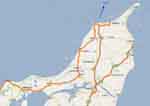 aboard
the ferry bound for Kristiansand in Norway. We did not know when the departures
of the ferries were due and when we had arrived in Hirtshals, we learned that
the ferries departing at 1.15 and 3.00 p.m. had already left for Kristiansand.
The next ferry was that night at 0.45 a.m. but it was all booked! We could be
put on the waiting list, but no promise. The remaining ferries for tomorrow were
also booked up. We learned over the phone that there was available place on the
ferry to Göteborg of 10.00 p.m. departing Frederikshavn (150 km), but those
ferries are nearly three times more expensive than these from Hirtshals. We got
finally OK for tomorrow morning on a ferry of 10.00 a.m. for Oslo. We booked our
trip, bought the ticket and then went for a walk to the beach in
Tannisby. Before the evening (about 9.00 p.m.)
we returned to Hirtshals (VIDEO
7). In its fishing harbour Carla prepared a nice dinner.
At 12.00 p.m. we loaded ourselves onto beds after having found a nice and quiet
parking lot behind a bank, in the centre of Hirtshals.
aboard
the ferry bound for Kristiansand in Norway. We did not know when the departures
of the ferries were due and when we had arrived in Hirtshals, we learned that
the ferries departing at 1.15 and 3.00 p.m. had already left for Kristiansand.
The next ferry was that night at 0.45 a.m. but it was all booked! We could be
put on the waiting list, but no promise. The remaining ferries for tomorrow were
also booked up. We learned over the phone that there was available place on the
ferry to Göteborg of 10.00 p.m. departing Frederikshavn (150 km), but those
ferries are nearly three times more expensive than these from Hirtshals. We got
finally OK for tomorrow morning on a ferry of 10.00 a.m. for Oslo. We booked our
trip, bought the ticket and then went for a walk to the beach in
Tannisby. Before the evening (about 9.00 p.m.)
we returned to Hirtshals (VIDEO
7). In its fishing harbour Carla prepared a nice dinner.
At 12.00 p.m. we loaded ourselves onto beds after having found a nice and quiet
parking lot behind a bank, in the centre of Hirtshals.
The 9th Day – 13.06.1995 - Tuesday: Hirtshals (DK) - Oslo (N) - Vikersund (N) – 104/2.628 km
In
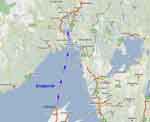 the
morning we got up at 7.00 a.m. and at 8.00 a.m. we had to clear from the parking
lot again, since the bank’s employees started to arrive in bulks and to park
their cars around our camper. We did not want to listen to possible objections
concerning the private parking lot, and although no one had knocked at our
window and nobody gave as a nasty look or said something, we withdrew quietly
from the battlefield. After having brought our sleeping space and the camper in
order on another camping lot, we went at 8.40 a.m. to the harbour, confirmed our
documents for getting aboard the ferry and started queuing in front of the
ferry (VIDEO
8). The customs and passport control equalled to zero. At 9.45 a.m. sharp the
process of entering the womb of the ferry started, at 10.00 a.m. the mooring
lines were heaved aboard.
the
morning we got up at 7.00 a.m. and at 8.00 a.m. we had to clear from the parking
lot again, since the bank’s employees started to arrive in bulks and to park
their cars around our camper. We did not want to listen to possible objections
concerning the private parking lot, and although no one had knocked at our
window and nobody gave as a nasty look or said something, we withdrew quietly
from the battlefield. After having brought our sleeping space and the camper in
order on another camping lot, we went at 8.40 a.m. to the harbour, confirmed our
documents for getting aboard the ferry and started queuing in front of the
ferry (VIDEO
8). The customs and passport control equalled to zero. At 9.45 a.m. sharp the
process of entering the womb of the ferry started, at 10.00 a.m. the mooring
lines were heaved aboard.
Our ferry M/S "Color Festival" (2 FOTO) was built in 1985/86 in the Wärtsilä shipyard in Finland and reconstructed in Bremerhaven, Germany in 1992. The port of registry: Oslo. It had 34.314 grt, the length 168 m, breadth 27,60 m, draught 6,50 m. The superstructure is 30 m long. Four Semt Pielstick diesel motors (totaling a 26.400 kW rated output) provided for a speed of 22 knots. She was of 2.000 passengers and 400 cars carrying capacity. Nine decks, 588 passenger cabins and 1.937 passenger bunks.
The crossing of Skagerrak was very smooth in
spite of the choppy sea, being, however, relatively negligent for this huge
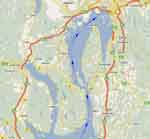 vessel.
And the stabilizing fins had been in operation probably. Here and there the sun
pierced a bit through the clouds, but a strong and cold wind was blowing. Carla
and I endured to stay on the open deck, in lee and in sun, clad in thick
pullovers and wind jackets (in summer?) for half an hour (VIDEO 9), and then fled into the
vessel’s interior, to have a coffee and a beer. At the end we sat down in the verandah-lounge in the forepart of the vessel, under the bridge, provided with
huge panoramic windows facing the travelling direction and over the bow, and we
had been sitting there watching the whole run from entering the Oslo fjord to
Oslo city (taking two hours). We enjoyed even a show programme meanwhile. We
watched the entrance to the very harbour from the open deck. The run through the
Fjord was under a relatively sunny weather. The bay in front of Oslo was
over-packed with sailing and motor boats of all kinds (VIDEO
10). We had also seen how a
smaller ferry had run over a small sailing boat (sloop) with two persons aboard.
The ferry made a turn and returned back, two smaller motor boats came to help,
but not a trace of the two. After some while (3-5 minutes), they had righted up
the overturned sailing boat, the white sail came out of water and finally we saw
how they had pulled out two persons with life jackets. All OK!
vessel.
And the stabilizing fins had been in operation probably. Here and there the sun
pierced a bit through the clouds, but a strong and cold wind was blowing. Carla
and I endured to stay on the open deck, in lee and in sun, clad in thick
pullovers and wind jackets (in summer?) for half an hour (VIDEO 9), and then fled into the
vessel’s interior, to have a coffee and a beer. At the end we sat down in the verandah-lounge in the forepart of the vessel, under the bridge, provided with
huge panoramic windows facing the travelling direction and over the bow, and we
had been sitting there watching the whole run from entering the Oslo fjord to
Oslo city (taking two hours). We enjoyed even a show programme meanwhile. We
watched the entrance to the very harbour from the open deck. The run through the
Fjord was under a relatively sunny weather. The bay in front of Oslo was
over-packed with sailing and motor boats of all kinds (VIDEO
10). We had also seen how a
smaller ferry had run over a small sailing boat (sloop) with two persons aboard.
The ferry made a turn and returned back, two smaller motor boats came to help,
but not a trace of the two. After some while (3-5 minutes), they had righted up
the overturned sailing boat, the white sail came out of water and finally we saw
how they had pulled out two persons with life jackets. All OK!
We docked in Oslo at 6.30
p.m. after eight and half hour of sailing. We disembarked in the harbour without
any customs and passport formalities and left Oslo
to find place for sleeping. We left the “city zone” and ma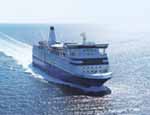 de
with this a mistake for which we paid later. Carla had wanted to see also Oslo
on that very day, and thus we returned
de
with this a mistake for which we paid later. Carla had wanted to see also Oslo
on that very day, and thus we returned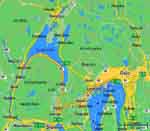 ,
but to enter the Oslo city we had to pay the entrance fee (NKr 12 = 3.000
Italian liras). It seems that they try to diminish by this measure the
unnecessary influx of cars in the city reducing in this way the traffic and
congestion problems. We found a parking lot (3.500 Italian liras per hour).
During an hour and a half we crisscrossed the town centre. Far too short for
Oslo! It’s very nice and all full of young people. All coffee shops and
restaurants chock full and everything very expensive. We paid for two beers in a
student pub in a park NKr 50 = 12.500 Italian liras, and on a column we saw an
advertisement for a hamburger at the same prize. For one hamburger!
,
but to enter the Oslo city we had to pay the entrance fee (NKr 12 = 3.000
Italian liras). It seems that they try to diminish by this measure the
unnecessary influx of cars in the city reducing in this way the traffic and
congestion problems. We found a parking lot (3.500 Italian liras per hour).
During an hour and a half we crisscrossed the town centre. Far too short for
Oslo! It’s very nice and all full of young people. All coffee shops and
restaurants chock full and everything very expensive. We paid for two beers in a
student pub in a park NKr 50 = 12.500 Italian liras, and on a column we saw an
advertisement for a hamburger at the same prize. For one hamburger!
We were lucky that the weather was dry and it was not so cold either. At 9.30 p.m. we departed towards west by the motorway for Drammen, left the motorway at the place Tranby and along the southern shore of the Tyrifjorden Lake we arrived to Vikersund at 11.15 p.m. We parked on a soccer playground parking lot, a peaceful, quiet place, far from the road and traffic, but the rain had drummed all the night over the roof.
The 10th Day –
14.06.1995 - Wednesday: Vikersund -
Kaupanger – 342/2.970 km 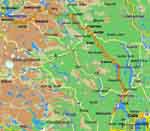
We departed for Hønefoss
only at 10.38 a.m., after the breakfast, at a cloudy and rainy weather. In the
centre of Hønefoss
we passe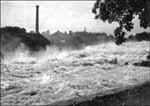 d over a bridge next to a wonderful waterfall
(FOTO). After 300 m we found a
parking lot and returned
on foot to the bridge to shoot a film
(VIDEO 11) and to admire these marvellous falls which
are situated practically in the middle of Hønefoss and on which the bulk of the
Hønefoss tourism is based (foss = waterfall).
d over a bridge next to a wonderful waterfall
(FOTO). After 300 m we found a
parking lot and returned
on foot to the bridge to shoot a film
(VIDEO 11) and to admire these marvellous falls which
are situated practically in the middle of Hønefoss and on which the bulk of the
Hønefoss tourism is based (foss = waterfall).
After this we started by a
good road (with E16) in direction of Sognefjorden and through
Granum, Bagn,
with museum
(VIDEO 12) and church from the year 1250
(VIDEO
13),
Aurdal, Fagernes,
Slidre, with a
beautiful lake
(VIDEO
14),
Lomen,
Ryfoss, with a beautiful waterfall
(VIDEO 15),
Vang,
Øyo, with a church
which was built in 1125 and is one of the oldest churches in Norway (VIDEO 17)
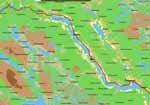 and Borgund
we arrived, always with E16 to Revsnes, all the time in
cloudy weather, but pleasant for driving. The road leads from one lake to
another one, difficult to say which is nicer. As soon as one lake ends, the next
one starts right away after a hill. If beyond the hill there is no another lake,
then there is for sure some
and Borgund
we arrived, always with E16 to Revsnes, all the time in
cloudy weather, but pleasant for driving. The road leads from one lake to
another one, difficult to say which is nicer. As soon as one lake ends, the next
one starts right away after a hill. If beyond the hill there is no another lake,
then there is for sure some
 wonderful waterfall
(VIDEO 18) or canyon
(VIDEO 22). All lakes are big,
marvellous, surrounded by wonderful green fields and woods. Everything is clean,
tidy, the houses are made of wood, but beautiful, everything looks like freshly
painted.
wonderful waterfall
(VIDEO 18) or canyon
(VIDEO 22). All lakes are big,
marvellous, surrounded by wonderful green fields and woods. Everything is clean,
tidy, the houses are made of wood, but beautiful, everything looks like freshly
painted.
At one point the road we found an old "road sign" from the year 1687, which marked the fifth mile. At that time, the measure of the length of road was the mile, which corresponds to today's 11 km. Every mile was marked with a large milestone with the number of the mile. The "our milestone" bears the symbol "5 EN-MIL", the fifth mile (VIDEO 19)!
Roads are very
good.
The maximum allowed speed in Norway is 80km/hour (being
53 M/h respectively)
there were rare few ones who drove speedier than that. No one was pushing
forward to possibly overtake someone who was driving slowly. The headlights were
on all the time, a
were
on all the time, a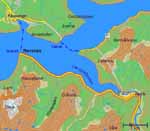 t daylight and under sun. The traffic was low, great for
driving. Among the lakes there are wonderful and
clean rivers, waterfalls
everywhere.
t daylight and under sun. The traffic was low, great for
driving. Among the lakes there are wonderful and
clean rivers, waterfalls
everywhere.
At the place Tyinkrysset, their known skiing centre, the road climbs to about 1.000 m over sea level up to a great lake, still party frozen (VIDEO 20). At Borgund we found a wonderful wooden church (VIDEO 21) from the 12th century (FOTO).
At 10.00 p.m. we reached finally Revsnes on the fjord shore, at 10.20 p.m. we boarded a ferry and crossed after twenty minutes to Kaupanger (VIDEO 23) on the other side of the Sognefjorden. It’s still daylight! We continued from there on, for some five kilometres, and next to an Esso gas station we parked, had dinner and went to bed. At midnight Carla was still reading her book at natural light conditions. It is midnight, but no night!
*)
In the
summer of
2010 (see Issue
2010 - 30th day)
I have (with the son
Peter) visited this
waterfall, but he no longer existed.
The river bed was completely dry,
although we were in a period with
a lot of rain?
**)
The ferry
Kaupanger
-
Revsnes
no longer exists.
The ferry runs
now
on the track
Fodnes
-
Mannheller (see
Diary Norwegen 2004
-
Day 53).
The 11th Day – 15.06.1995 - Thursday: Kaupanger-Olden – 279/3.249 km
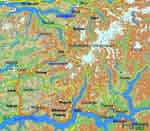 We started at 10.25 a.m. and through Sogndal
and Leikanger arrived in
Hella
(VIDEO 24). We got there aboard a ferry "Aurland"
and after 15 minutes we reached Dragsvik
(VIDEO 25).
From Dragsvik we continued for Balestrand
(VIDEO 26),
along the wonderful coast of the Sognefjorden
(FOTO).
In a cove with
small harbour, next to an islet Kvamsøy, and having a glorious panorama, sun, blue sea
and snow covered
We started at 10.25 a.m. and through Sogndal
and Leikanger arrived in
Hella
(VIDEO 24). We got there aboard a ferry "Aurland"
and after 15 minutes we reached Dragsvik
(VIDEO 25).
From Dragsvik we continued for Balestrand
(VIDEO 26),
along the wonderful coast of the Sognefjorden
(FOTO).
In a cove with
small harbour, next to an islet Kvamsøy, and having a glorious panorama, sun, blue sea
and snow covered 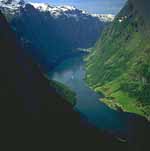 mountains
(VIDEO 27),
we lunched in a wonderful peace. Weather warm, sunny.
mountains
(VIDEO 27),
we lunched in a wonderful peace. Weather warm, sunny.
We continued our ride after lunch, passed the long tunnel for Høyanger and went on along the fjord shores to Vadheim. On a place next to the shoreline I wanted to try my fishing ability, with my first fishing rod, but Carla was not in favour of it and thus, this causing a small row (!!), the trip was continued over Vadheim towards the inland. On this leg of trip we saw houses, small, beautiful, however, having grass roof (VIDEO 28). Namely, the roof is covered by a thick layer of earth on which grass, nice and green, and somewhere small deciduous and pine trees are growing. Allegedly this is a good insulation for winter.
We passed Sande, Førde and Moskog, followed the marvellous shore of the Jølstravatnet Lake. Between Skei and Byrkjelo we have to make a stop on the road and wait until a herd of goats crossing the road (VIDEO 29). Then on to Innvikfjorden, continuing along its shores, Innvik and Olden. We stayed there overnight, close to the sea shore, having parked behind the local post office and library. There was a VW-camper form Netherlands (with four adults!!) and another one from Belgium.
We had a peaceful night with the morning quacking of sea gulls. Actually, all around us the sea gulls were hatching in their nests, in grass, next to the very shore path and staying with their freshly hatched out small sea gull chickens (VIDEO 30). Carla went to take pictures of them before evening, but the sea gull parents were flying low circling around her, with noisy protests or dangerous dives. They are not disturbed by any of the inhabitants, in spite of dwelling on roofs and letting out their droppings everywhere with no concern. Before dinner I “bathed the bait” in the sea, but it appears that the fishes did not understand my intention!! Actually, I had been fishing in the shallow waters, with bait and at the end of deep fjord, where there is no fish. But, I did not know this then!
The 12th Day – 16.06.1995 - Friday: Olden - Briksdal - Hellesylt – 120/3.369 km
We
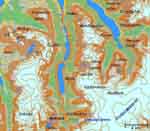 started
at 9.30 in the morning for Briksdal (12 km),
the place where a huge glacier, Briksdalsbreen,
is descending. We parked our camper next to a nice brook (water from the
glacier), at a distance of 50 m from the road, on a lonely place (the camper
could not be seen from the road) and left it to the mercy of that one who might
come across it (VIDEO 31). You can do this there, but don’t even think of it in the
civilized Europe!
started
at 9.30 in the morning for Briksdal (12 km),
the place where a huge glacier, Briksdalsbreen,
is descending. We parked our camper next to a nice brook (water from the
glacier), at a distance of 50 m from the road, on a lonely place (the camper
could not be seen from the road) and left it to the mercy of that one who might
come across it (VIDEO 31). You can do this there, but don’t even think of it in the
civilized Europe!
We started on foot towards the glacier, which we had watched already on our way from the camper from 10 km. distance. About 2.5 km were left yet to walk from our parking place at the brook to the glacier. After approx. 500 m we deviated from the road to the right on the path towards the glacier. After a shorter period the path disappeared, we couldn’t proceed, we were on the wrong one, but we saw then at the left side, another, greater glacier, in a different and till then hidden direction (VIDEO 32). We had to go back and to proceed by a different way towards that other glacier, since it was the right one.
On the parking lot for
buses, situated at about 2 km from the glacier, there were some 15 smaller
coaches, for 3-4 persons, with a harnessed horse, with which one could come, for
40.000 Italian liras, over a narrow road with hairpin windings, to 700-800 m from the very glacier. Chiefly the Japanese were
riding with coaches. We started of course on foot, by a mountaineering path
(VIDEO 33).
There was a brook next to the path, then a waterfall, and again the brook and a
waterfall again. All this was very nice in the gorgeous, sunny day. Where the
glacier ends (or where it starts) a small lake had been created and atop a small
rock, actually on a greater stone piercing the water surface for some 25 cm, a
sea gull had made a nest and was hatching on the eggs. The glacier is
marvellous,
hairpin windings, to 700-800 m from the very glacier. Chiefly the Japanese were
riding with coaches. We started of course on foot, by a mountaineering path
(VIDEO 33).
There was a brook next to the path, then a waterfall, and again the brook and a
waterfall again. All this was very nice in the gorgeous, sunny day. Where the
glacier ends (or where it starts) a small lake had been created and atop a small
rock, actually on a greater stone piercing the water surface for some 25 cm, a
sea gull had made a nest and was hatching on the eggs. The glacier is
marvellous,
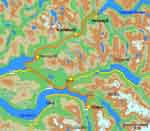 situated
between two mountains, not looking big from the vicinity. A group of four
mountaineers and with special outfit for ice (rented on the spot) started to
climb the glacier and after 10 minutes we lost them from sight. After a shorter
rest and few sandwiches we went back to our camper and, when we covered some
200-300 m, we saw again our mountaineers on the glacier. They looked like small
dots, however, they had still been on the foot of the huge glacier and only then
we realised how big it was
(FOTO).
situated
between two mountains, not looking big from the vicinity. A group of four
mountaineers and with special outfit for ice (rented on the spot) started to
climb the glacier and after 10 minutes we lost them from sight. After a shorter
rest and few sandwiches we went back to our camper and, when we covered some
200-300 m, we saw again our mountaineers on the glacier. They looked like small
dots, however, they had still been on the foot of the huge glacier and only then
we realised how big it was
(FOTO).
Around 5.00 p.m. we returned to our camper, found, of course, everything in order (VIDEO 34), and had a dinner in wonderful peace with a murmur of a mountain brook. It started to rain lightly. At 6.10 p.m. we were on our way and through Olden, Stryn, Hornindal and Kjellstadli we arrived in Hellesylt at 8.20 p.m. We parked on an empty bus parking lot, next to the fence of that parking lot situated next to the sea and enjoyed in the multitude of birds: sea gulls, ducks (VIDEO 35), geese and only God would know what other sorts of the sea flying flock.
We were getting ready for a trip by ship through the GeirangerfjordHellesylten up to Geiranger and back, the weather was half overcast with clouds, but it was not bad. It was not raining!
The 13th Day – 17.06.1995 - Saturday: Hellesylt - Molde – 347/3.716 km
The rain started at night time and it drummed over the roof the whole night. It was still raining in the morning, the sky was overcast and a sporadic fog was over the fjord. We were told in the tourist office that we would see nothing from board the ship at such weather conditions and that it would be better to come by when on our return trip (VIDEO 36). We changed the programme and at 9.40 a.m. we headed towards the place Stranda, where a ferry for crossing the Storfjorden makes the call. At 10.45 a.m. we boarded the ferry "Aure" and disembarked at the place Liabygda and continued from there in the direction of Ålesund, where we arrived at 12.30 a.m.
We
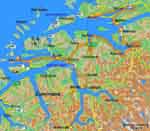 parked
in the port next to the bus station and made a walk through the town. Aboard a
fishing vessel we bought one litre of small crabs, “scampi”, (NOK 35 = 8.750
Italian liras) and Carla ate half of them on the way (VIDEO 37).
I think that they were only parboiled a little.
parked
in the port next to the bus station and made a walk through the town. Aboard a
fishing vessel we bought one litre of small crabs, “scampi”, (NOK 35 = 8.750
Italian liras) and Carla ate half of them on the way (VIDEO 37).
I think that they were only parboiled a little.
All windows on houses were utterly full with the sea gulls having their nests on the windows. Three nests per a window. They were hatching the eggs, nursing and feeding the chickens, making a terrible noise and shitting all the day and night on the window, on the wall under the window, on monuments, on benches, on sidewalks, everywhere. It appeared that also there, however, everything was permitted to the sea gulls (VIDEO 38).
We saw also a show in which choirs of some folklore group in national costumes appeared. Finally we went to the camper, parked on the quay-side offering a marvellous look at the sea and mountains, fried up the scampi and ate them with gusto. Regrettably, at half the lunchtime a great and empty bus arrived on the quay-site, covering partially the view of the fjord and mountains. After this the driver disappeared leaving the engine running all the time, to maintain probably the bus warm, and, thus partially ruined and made smoky our lunch . Shit! When we left, it was still strumming. Asshole!
At 3.30 p.m. we left for Skodje, Ørskog, Tresfjord, Åndalsnes and Åfarnes. At 7.45 p.m. we crossed over by the Stordal ferry bound for Sølnes and continued for Molde. We arrived to a tunnel which goes under the sea directly to Molde, saw the road toll of 40.000 Italian liras for using it, forsook the tunnel and deviated from this direction to the right and started over a narrow country road round the fjord to Molde. We were not quite sure whether this small road was at all crossable for our camper and whether it comes out to the main road at the end of the fjord. We vacillated during the drive several times whether to go back or not, but nevertheless after 45 minutes we reached Molde at 9.30.p.m.
It’s a small, beautiful place, nice port, full of young people, the central alley lined with blossoming trees, very clean and tidy. In general, all places we saw so far were very clean and tidy and the people were very accessible and kind.
We had our evening meal at the parking lot in the harbour, with the window of our camper above the sea, and then we withdraw to a wild camping ground at the entrance to Molde, some 20 metres from the sea again, where a German camper was parked already. I made some shots of Carla with the camera at night, at 1.00 a.m., on a small hill above the ground where we had parked, without any additional lighting. The days were getting ever longer and the nights were slowly disappearing (VIDEO 39).8
The 14th Day – 18.06.1995 - Sunday: Molde - Levanger – 385/4.101 km
Early in the morning
(already at 11.15 a.m.!!!) we moved further on towards the north
(VIDEO
40). As the first
thing (for the purpose
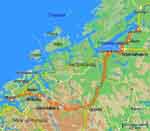 of
camera shooting) we took a drive through the place showing not a living soul on
the street. Sunday at noon! We proceeded towards the Norway’s inland and passed
through Kleive,
Eidsvåg, Sunndalsøra and
Oppdal taking there a new direction to the
north again for Trondheim. The day was
beautiful and sunny, all small places we were passing through were tidy and very
clean, but literally, we did not see a living soul anywhere around. A cat or a
dog, either! As if everything died out. It was Sunday?! But on the road in front
of Trondheim we run into a heavy car traffic heading towards the town. We
entered the town under rain. Up to the present day we had rain everyday, some
day more, some day less, but every day indeed!
of
camera shooting) we took a drive through the place showing not a living soul on
the street. Sunday at noon! We proceeded towards the Norway’s inland and passed
through Kleive,
Eidsvåg, Sunndalsøra and
Oppdal taking there a new direction to the
north again for Trondheim. The day was
beautiful and sunny, all small places we were passing through were tidy and very
clean, but literally, we did not see a living soul anywhere around. A cat or a
dog, either! As if everything died out. It was Sunday?! But on the road in front
of Trondheim we run into a heavy car traffic heading towards the town. We
entered the town under rain. Up to the present day we had rain everyday, some
day more, some day less, but every day indeed!
We parked on a small parking lot and went for the town sightseeing. Fortunately the rain had stopped and it was possible to take a walk through the town. A very nice cathedral (VIDEO 41), the town very clean, but desolate. It was about 7.00 p.m., hardly anyone on the street. We filmed the cathedral, the town centre, a bay with typical houses on wooden pillars in water (VIDEO 42). At 8.30 p.m. we started by a coastal road (to avoid the motor way) through Stjørdalhalsen and Åsen for Levanger, where we arrived at 10.00 p.m. under rain. Carla had wanted that we park inside the very place, so we were looking for a parking lot but without success and at the end we returned back to the entrance to the town and parked on some shopping centre’s parking lot. Nice and green next to the sea shore. Another two campers were there. Let us hope that we would not be chased away tomorrow morning, when the shopping centre starts operating. The rain stopped, we prepared the evening meal and watched the sea and the sea gulls. After the meal we got ready for bed. The rain started and drummed again over the roof the whole night.
The 15th Day – 19.06.1995 - Monday: Levanger - Laksfossen – 441 /4.542 km
The morning was sad and pissed off. It was
raining when we heaved our anchors at 9.20 a.m. and started by the E6 in the
direction of Narvik, always heading north. We drove along the
Trondheimsfjorden up to
Steinkjer and then by the north side of the huge and wonderful
Snåsavatnet Lake up to Vegset
and all further, all the time under the rain, up to
Gartland. The road (E6) leads towards north through the Norway’s
inland, half way between the sea and Swedish border. Here, in Gartland, Carla
was very much convinced that at the seaside marvellous weather prevails and we
turned right away to the left to the road 775, direction
Høylandet and continued on by the road 17 over
Foldereid to Holm
at the seasi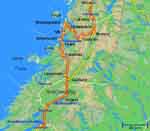 de.
But at the seaside the only thing that was nice was a nice rain, the same one as
in inland.
de.
But at the seaside the only thing that was nice was a nice rain, the same one as
in inland.
From Holm we crossed by the ferry "Lysingen" over to Vennesund (VIDEO 43), continuing on by road through Vik to Brønnøysund. We bought there wonderful fillets of cod fish for dinner. We decided nevertheless to return to the inland and continue towards the north. To continue by ferry from island to island is very expensive, and the roads over these low islands lead through the islands interior and thus the sea cannot be seen thus either. Here, no road is leading north alongside the shoreline, one should cross by ferry from island to island and, considering that it was raining, no good reasons for this existed.
We started over Hommelstø and on a wet downgrade we ran into a couple of two big wild geese which were walking, one in the middle of the road and the other one along the road edge. We tried to drive slowly, but they walked before us showing no intention to move from the road. When we accelerated a bit, they spread their wings a little more, but they did not take off and they too accelerated their steps waddling in their try to be as quick as possible. Finally, they moved to side towards the road edge nevertheless and we took them over slowly. Of course, Carla had recorded all this by camera and we have a wonderful souvenir (VIDEO 44).
We continued along the gorgeous Tosenfjorden, after Tosbotn we went over a snow covered mountain, passed a frozen lake and came finally out onto the E6 again at the place Brenna. This excursion to the seaside cost us some additional 150 km. Senseless! Now we continued north towards Mosjøen, but after 35 km we stopped at wonderful Laksfossen waterfalls, at the place Laksfors. We parked there, made shots with camera (VIDEO 45), had a short evening meal and slept there overnight. The weather had improved!
The 16th Day – 20.06.1995 - Tuesday: Laksfossen - Fauske – 474/5.016 km
We woke up with a nice weather (VIDEO 46) and at 10.30 a.m. we started towards north. We went through Mosjøen, Korgen, Mo i Rana (VIDEO 47) and had our lunch at the shore of one wonderful, clear river (VIDEO 48). Everything was gorgeously green. Upon lunch we continued our journey and after some 20 minutes we reached the northern polar circle. It is of interest that 2-3 km before the polar circle the polar landscape commences, too: snow covered plateau, white, desolate, without a single tree, and before this everything was so lush and green. At the polar circle parking lot, a great pavilion that deals with profitable selling of souvenirs and postal picture cards, and of course, buses, campers, trucks, trailers and other vehicles parked in masses. All around snow and nothing else, but everybody was stopping, buying picture cards and calling home or acquaintances from the polar circle. I ran across also on a monument with the five point star sign in memory of Yugoslav detainees of the W.W. 2 written in Croatian and Norwegian language (VIDEO 49)!
We
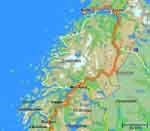 moved
on, drove alongside the railway track and took over a cargo train. This is a
sole railway line here in northern Norway above Trondheim. It reaches the small
town Fauske, where we intended to arrive
that evening, ending there, this meaning that the northern half of Norway has no
railway line at all. Actually, another railway line appears (from 1903) in the
north, at Narvik, but it goes from Narvik straight to Sweden towards the mines
in Kiruna and its length in Norway is of only some 20 km. It serves the Swedish
for exportation of iron ore from Kiruna. But therefore the roads in Norway are
excellent indeed, somewhere they are also narrow, but the upper layer is good,
smooth and undamaged. This is surprising a bit considering the local harsh
winters.
moved
on, drove alongside the railway track and took over a cargo train. This is a
sole railway line here in northern Norway above Trondheim. It reaches the small
town Fauske, where we intended to arrive
that evening, ending there, this meaning that the northern half of Norway has no
railway line at all. Actually, another railway line appears (from 1903) in the
north, at Narvik, but it goes from Narvik straight to Sweden towards the mines
in Kiruna and its length in Norway is of only some 20 km. It serves the Swedish
for exportation of iron ore from Kiruna. But therefore the roads in Norway are
excellent indeed, somewhere they are also narrow, but the upper layer is good,
smooth and undamaged. This is surprising a bit considering the local harsh
winters.
After the polar circle parking lot we drew towards north over the plateau, being in that snowy mood, and over the bare landscape for some 5-6 km, and then the road started to descend and all of a sudden the snow disappeared again and everything became lush and green and in flowers. As in a fairy tale! Or, if someone wanted to demonstrate that there, given the polar circle is going through, the climate should be polar, too.
We stopped at a gorgeous blue river that was descending in a very noisy rapid and enjoyed the landscape. We continued on and arrived into Fauske and proceeded to Bodø. This was a bit out of the way, but we wanted to park somewhere, to fish and possibly stay overnight. But, there was no access to the sea, the road led to close to the steep shore making it impossible to stop for parking. Anyway, the weather was so wonderfully sunny. The ferry directly to the Lofoten Archipelago sails from Bodø, and there had been a significant number of vehicles in a long line and, allegedly, this transport was rather expensive. We did not have this ferry in our plan (we ignored its existence) and eventually we returned to Fauske, again 150 km for nothing! We settled in Fauske on a wonderful parking lot next to the very sea and slept over in a perfect peace.
The 17th Day – 21.06.1995 - Wednesday: Fauske - Bognes - Lødingen - Stokmarknes – 265/5.281 km
During the night it started
to rain again. We departed towards north under rain at 8.50 a.m. Through
Straumen and Strinde
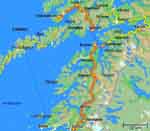 we
arrived in Bognes at the seaside intending
to take the ferry for Skarberget in
direction of Narvik, where from we wanted to descend towards south to islands
Lofoten. In the last moment we changed our
minds and took the ferry for Lødingen on the
island of Hinnoya, belonging to the group of
Vesterålen
Archipelago, in the north of Lofoten. Through this we had shorten that leg of
trip to a certain degree, but, regrettably, we shall not see Narvik.
we
arrived in Bognes at the seaside intending
to take the ferry for Skarberget in
direction of Narvik, where from we wanted to descend towards south to islands
Lofoten. In the last moment we changed our
minds and took the ferry for Lødingen on the
island of Hinnoya, belonging to the group of
Vesterålen
Archipelago, in the north of Lofoten. Through this we had shorten that leg of
trip to a certain degree, but, regrettably, we shall not see Narvik.
After an hour drive we reached Lødingen with the marvellous ferry "Tysfjord" at 1.30 p.m (VIDEO 50). Right away upon leaving the ferry we stopped on the quay-side, had our lunch meal and then continued on for Sortland. In Sigerfjord we parked next to the road and walked out over a wooden wharf. The water was clear there, but with a lot of grey medusas with a diameter of 10-15 cm, and a great shoal of fishes passed by. We went right away for our fishing gear, but it appeared that, also that time, the fishes did not take us seriously. We just bathed the bait, but nothing tugged. And Carla, too, tried for the first time to throw the hook. But nothing for her either. We continued over a wonderful new bridge and arrived in Stokmarknes. The weather improved during this leg of trip, we had no rain from Ledingen and a bit of sun made its appearance, too. We parked on a marvellous parking lot in the centre of the place, everything in green, with a beautiful view of fjord and mountains. We made a walk before the evening meal and had a good night sleep in a wonderful peace.
The 18th Day – 22.06.1995 - Thursday: Stokmarknes - Henningsvær – 88/5.369 km
Next morning, at about 8.00 hours a.m., our
parking lot started to get filled with cars. But no one told us anything. At
9.15 we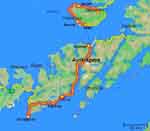 were in a small harbour and bought directly aboard a small fishing vessel a
saithe (coalfish) of approx. 1,5 up to 2 kg for NOK 20 (Lit 5.000). That’s free
of charge! A kilo of potatoes cost NOK 17 in the shopping centre. It was dearer
than the salmon! At 10.00 we were in the tourist office, and then we started
over a small, secondary but well asphalted road around the island that leads
through Breivik and
Ånstad.
were in a small harbour and bought directly aboard a small fishing vessel a
saithe (coalfish) of approx. 1,5 up to 2 kg for NOK 20 (Lit 5.000). That’s free
of charge! A kilo of potatoes cost NOK 17 in the shopping centre. It was dearer
than the salmon! At 10.00 we were in the tourist office, and then we started
over a small, secondary but well asphalted road around the island that leads
through Breivik and
Ånstad.
We stopped on a smaller plateau next to
the sea (VIDEO
51). The weather was sunny, not a living soul anywhere. Every 5 or 10
minutes a single car passed by slowly, otherwise the silence prevailed and only
the bleating of sheep grazing on the hill could be heard, actually of one
single sheep solely, calling someone all the time. We went on the rocks, again I
had bathed the bait, but it appeared that long all the coast the fishes were
utterly unserious. Not a single one to try to tug. For our lunch we had one
saithe, very nice, with the salad of dandelion leaves which Carla had
picked up while I was” fishing”. There ass an abundance of dandelions and for
sure they were not contaminated.
At 3.00 p.m. we arrived at Melba where we got aboard the ferry "Moysanen" and
were transferred to Fiskebøl. We left
Melbu with nice weather, the sun was not
actually shining, but the Lofoten received us with cloud wrapped mountains, with
chilly wind and drizzle. The impression was of a late autumn: low clouds, snow
at the altitude of 100 m over sea level. And the summer had begun yesterday
(VIDEO
52). But
this has not diminished the beauty of Lofoten. They look like islands from a
fairy tale, the mountains rise steeply from the sea and are
lost
in clouds. We arrived from Fiskebol over Svolvær
to Heningsvær. We were met there with sun,
however (VIDEO
53). This is small settlement with a fishing harbour which appears to be
becoming a centre for gathering of fishing vessels in this part of the Atlantic
during winter or spring months.
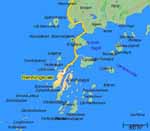 Before
the very settlement we struck on huge areas of wooden racks with dried cod fish
(stock fish). In quantities counted in truckloads (VIDEO
54).
Before
the very settlement we struck on huge areas of wooden racks with dried cod fish
(stock fish). In quantities counted in truckloads (VIDEO
54).
We parked on a parking lot, just at the entrance to the place. We made a walk through the whole settlement. The stock fishes were hanging in front of every house and the wooden racks, on which the stock fishes are dried, were as big as tennis courts. It appeared that the seagulls had no interest to steal, because this flesh is too hard for them.
At 8.00 p.m. I tried to fish in a small cove just behind the parking lot and finally I caught the first fish. It looked like kind of a big gudgeon (goby) of about ¼ kg, it had a big head and little flesh so we decided to through it back into the sea. And then within half an hour I managed to catch three nice saithes (VIDEO 55), greater to some extent than a greater mackerel. They were five in all, but two of them were nevertheless not serious enough and they got loose when leaving the sea surface. We had a nice, very nice evening meal, with vodka and wine. It was necessary to darken all windows at the night time, as there is no night. All the night is the day! Nice play of words, but so it is! The weather was promising well!
The 19th Day – 23.06.1995 - Friday: Henningsvær - Å – 160/5.529 km
At night (or better at the daylight, since here the night does not exist) a strong north-eastern wind started to blow and in the morning it was cold to die. The sky was overcast with thick and low clouds. We left at about 10.00 a.m. and soon the rain started. It was a real atmosphere of a late autumn, but very cold. We started via Lyngyær and after the bridge over Gimsøystraumen we went to the right to tour the Gimsøy island (VIDEO 56) through the small places of Gimsøy, Vinje and Vik. During the tour we have had a very strong stormy wind, as it can be nicely seen in the film which we had shot during our trip.
When we struck again the
main road immediately before the bridge for Smorten,
we turned off for the bridge, but we had
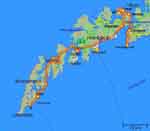 to
make a stop, since something was lying on the lane on the bridge, like three dry
boughs, at least it appeared so from the distance. Carla descended from the
camper to remove them. I saw that she had picked them up from the lane and to
carry them to the camper. Actually, they were three wonderful, big dry cod
fishes. They had dropped probably from a truck. We put them later into the box
on the camper’s roof and brought them to San Maurizio.
to
make a stop, since something was lying on the lane on the bridge, like three dry
boughs, at least it appeared so from the distance. Carla descended from the
camper to remove them. I saw that she had picked them up from the lane and to
carry them to the camper. Actually, they were three wonderful, big dry cod
fishes. They had dropped probably from a truck. We put them later into the box
on the camper’s roof and brought them to San Maurizio.
We continued through the places of Stamsund for Leknes, all the time under heavy rain and strong wind, with low clouds which had regrettably covered the view of all mountain peaks. And just these mountains are that what is so nice on Lofoten which are full of these protruding out of the sea! Finally the sun penetrated after we left Leknes, but the strong cold wind remained. We had for lunched the delicious fish, on a parking lot next to the road, enjoying the marvellous sight of the choppy fjord lit with sunshine. It was nicely warm inside the camper, the sun was warming us (VIDEO 57). We passed through the underwater tunnel between the Vestvagøya and Moskenesøya islands (against a substantial toll). In some smaller place we saw from atop the road, a small harbour Napp with a mass of seagulls which circled over the harbour. We stopped and saw that two fishing vessels were moored to the posts in front of a building and that the majority of seagulls were circling there (VIDEO 58). There was fish probably, maybe for sale as well. Carla went to ask information and returned with a huge cod (of 2-3 kilos). Down there the fish was processed by cleaning it for delivery (the offal was thrown into the sea – hence the seagulls) and Carla asked whether they would sell her one fish. A guy gave her right away that cod as a gift. We returned there and gifted him a litre of Italian wine. He more than happy, we pleased.
We continued the trip towards south under rain, wind and bad weather (VIDEO 59). Regrettably, we did not see anything of their marvellous white beaches, of wonderful colours of that sea. Instead, all was grey, wet and cold. Pity! We went through the small fishing hamlet Reine which looked like being drowned in the water. All around it the sea, rain from above, water underneath (VIDEO 60). We arrived at about 7.30 p.m. to the most southern point of the Lofoten road, which terminates there abruptly on a short and soft ascent portion. A settlement with the shortest name possible, one letter only, is located there! Its name is Å! We have thought that in geographic indexes or lexicons it should be surely found on the first position in the index of places, but in the Norwegian atlases it is not so! In the Norwegian alphabet the letter Å is found on the last position.
We parked on a great parking lot over the settlement and had a part of the cod for dinner. At 20 metres away from us there was no more continuation of the road towards south. We have reached the end. The weather persisted to remain bad.
The 20th Day – 24.06.1995 - Saturday: Å - Utakleiv – 102/5.5631 km
We woke up with rain and cold weather. After breakfast we fed seagulls and made snap shots of them when they were fighting for the leftovers of cod of our dinner (VIDEO 61). We made a short excursion from the parking lot (some hundred metres) towards south, up to the rock rising from the sea, over the wet moss. It was not possible to proceed on, as the island terminates there. We returned with wet feet! On the parking lot we met a young married couple from the surroundings of Frankfurt: Martina and Martin. Nice people!
We started our return trip long the Lofoten, towards the north, about 10.00 a.m. Immediately after the country Moskenes, we stopped at a small cemetery situated next to the very road and having no fencing wall of any kind. It is placed on a narrow, little sloppy ground, going in parallel with the road (67.905 13.045). The cemetery was covered with green nicely mowed grass and in the grass small, just simple tombstones had been placed. All was full of flowers. Individual tombs cannot be told one from the other, since they have no mounds. All is level. Only small tombstones, flowers and the exquisitely mowed grass existed. All full of colours and without those unpleasant grey, concrete walls, as with us. It was nice to screen this and so we did it (VIDEO 62).
After a short drive we reached Reine, a very pretty, small and picturesque fishermen settlement, with a small, natural but well protected port for fishing vessels. The weather improved and the sun protruded. In that instant the settlement was much nicer than that one through which we had passed the day before. We stopped, parked our vehicle within the place and made a walk. Everything is full of cod fish being dried. The surfaces of two-three tennis play courts, maybe even more, had been covered with cod fish (VIDEO 63). We met again Martina and Martin.
We moved on and after some
kilometres we stopped on the road above the shore and had lunch. The weather was
nice and we decided to try our luck in fishing. We had fished in the manner as
shown in San Maurizio, with a float and under it a small hook with bait.
First time in my
life I have
fished
with
a
fishing rod
two days ago
and
Carla
makes it the
first time today!!
Carla
had picked up limpets ands they were used as baits and it worked! This time the
fishes ha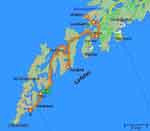 d
understood and after an hour we had in our nylon bag 13 nice saithes. Carla had
also fished and she caught 5-6 pieces
(VIDEO
64). They were as big as those of the day
before yesterday, i.e. they were something bigger than our mackerels. We caught
actually some 14, but one was something smaller and we threw it back into the
sea. But poor creature, it did not manage to dive deeper, a seagull nose dived,
got hold of him, took off and swallowed it in flight. The fishing turned at the
end to be such, that when we threw the hook it instantly tugged and it was
necessary to hook the fish by a quick jerk only and to throw it on the rock.
Some of the fishes got off the hook and fell into sea, as we stood on a sloped
slippery rock. It was difficult to stand there and even more complicated to free
the fishes from the hook. And it was all under a
wonderful, sunny weather conditions, relatively warm. Carla did not want that we
continue fishing, since it was too much for us, and it is senseless to throw
away the fish. However, she was enthusiastic with fishing.
d
understood and after an hour we had in our nylon bag 13 nice saithes. Carla had
also fished and she caught 5-6 pieces
(VIDEO
64). They were as big as those of the day
before yesterday, i.e. they were something bigger than our mackerels. We caught
actually some 14, but one was something smaller and we threw it back into the
sea. But poor creature, it did not manage to dive deeper, a seagull nose dived,
got hold of him, took off and swallowed it in flight. The fishing turned at the
end to be such, that when we threw the hook it instantly tugged and it was
necessary to hook the fish by a quick jerk only and to throw it on the rock.
Some of the fishes got off the hook and fell into sea, as we stood on a sloped
slippery rock. It was difficult to stand there and even more complicated to free
the fishes from the hook. And it was all under a
wonderful, sunny weather conditions, relatively warm. Carla did not want that we
continue fishing, since it was too much for us, and it is senseless to throw
away the fish. However, she was enthusiastic with fishing.
We moved on with our rich catch and on a splendid beach with white sand (all beaches on Lofoten have the wonderful white sand, and in sun the sea shows the turquoise colour) we had cleaned the fish. Who came again across us? Martina and Martin! They admired our catch. Martina helped us to clean the fish and we invited them to dinner. But they had in their programme some more sightseeing, so we agreed to find ourselves at 8.00 p.m. in the cove in front of Utakleiv (some 25 km to north). We had found this cove on the map. It looked sufficiently lonely and favourable for dining and staying overnight.
After this we moved into the small nice Nusfjord (VIDEO 65), and afterwards we reached over Leknes and Leitebakken the sea in front of Utakleiv where, on an enlarged portion of the road, nearly next to the very sea, we had parked our camper and made preparations to spend the night. Not a living soul behind and in front of us for at least two kilometres. Ideally! But the weather deteriorated again! About 8.00 p.m. Martina and Martin arrived and parked behind us on the same road enlargement. We dined together the nice fish accompanied by cognac, beer and wine. Chatted till 1.00 in the morning, at daylight, and then went to bed. I think that during the night time one car had bypassed us on the road.
The 21st Day – 25.06.1995 - Sunday: Utakleiv - Gratangenfjord – 326/5.957 km
We took our leave of Martina
and Martin in the morning (VIDEO
66) and tried to carry on in direction of
Utakleiv and on, around the peninsula, but the
road terminated in Utakleiv and we had to turn back
(VIDEO
67). The weather was not
actually nice, bit it did not rain. We headed again through
Leitebakken and Borge,
where the rain started, and through
Svolvær
arrived in Fiskebøl at 1.30 a.m
(VIDEO
68). We started
queuing for the Melbu ferry that was
supposed to sail off at 2.40 p.m. only. While waiting, Carla had prepared a nice
lunch and, after it, we had our coffee in peace and boarded the ferry "Moysalen".
We docked i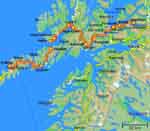 n
Melba at 3.10 p.m. Then we continued under heavy rain over
Stokmarknes to
Sortland and from there under heavy rain and even stronger wind for
Sigerfjord, Kanstad,
Kongsvik, always with E10. There, the rain subsided a bit,
but the wind was still very strong, the sea became white, and in front of us
there was a great bridge "Steinslandstraumen bru" that passes high over the
Tjeldsund strait, which we had to cross
(VIDEO
69). With
that mighty wind, with the given height of our camper and the surface exposed
vertically to the wind it was not very funny to cross the highly situated and
long bridge. But there was no alternative. The wind tried to dangerously swerve
us from our direction. Deep under us the strait full of white crests, as in the
case of Senj*) bora. Finally, we reached the opposite side, turned to left
towards north and after some time we parked at
Fornesvik, above the sea. It did not rain any more, the parking lot
was in the leeside, the wind was depicting wildly its shadows over the sea
surface, the sea and the mountains around bathed in wonderful colours, dark,
light, blue, green and violet, we enjoyed this view at the big
Vågsfjorden, indescribable indeed. We continued
to Rensa and
Grovfjorden, all up to a parking lot on the road at
Tjuvskjær in
Gratangenfjorden, where we arrived at about 6.30.p.m. I have tried
also to fish, for short time and without success, although a Frenchman, some 150
m away from us, had managed to pull out within two hours a mass of fish (some 30
nice saithes). I thought then that he was having more patience or some better
bait than I, however, I am sure today that he had had another fishing technique,
the one that we learned later, in the north!
n
Melba at 3.10 p.m. Then we continued under heavy rain over
Stokmarknes to
Sortland and from there under heavy rain and even stronger wind for
Sigerfjord, Kanstad,
Kongsvik, always with E10. There, the rain subsided a bit,
but the wind was still very strong, the sea became white, and in front of us
there was a great bridge "Steinslandstraumen bru" that passes high over the
Tjeldsund strait, which we had to cross
(VIDEO
69). With
that mighty wind, with the given height of our camper and the surface exposed
vertically to the wind it was not very funny to cross the highly situated and
long bridge. But there was no alternative. The wind tried to dangerously swerve
us from our direction. Deep under us the strait full of white crests, as in the
case of Senj*) bora. Finally, we reached the opposite side, turned to left
towards north and after some time we parked at
Fornesvik, above the sea. It did not rain any more, the parking lot
was in the leeside, the wind was depicting wildly its shadows over the sea
surface, the sea and the mountains around bathed in wonderful colours, dark,
light, blue, green and violet, we enjoyed this view at the big
Vågsfjorden, indescribable indeed. We continued
to Rensa and
Grovfjorden, all up to a parking lot on the road at
Tjuvskjær in
Gratangenfjorden, where we arrived at about 6.30.p.m. I have tried
also to fish, for short time and without success, although a Frenchman, some 150
m away from us, had managed to pull out within two hours a mass of fish (some 30
nice saithes). I thought then that he was having more patience or some better
bait than I, however, I am sure today that he had had another fishing technique,
the one that we learned later, in the north!
The weather was always cloudy, some light drizzle, but without some wind. The parking lot was situated on an uplift ground above the fjord, rather in the open. A terrible wind arose anew during the night that caused our camper to wobble, so that it was not possible to sleep. At 3.30 a.m. at the night time, under the sun that protruded through the clouds, we had to move away 2 km to in a small fishing cove, perked close to sea and had a peaceful night sleep.
*) Senj: a small town in Craotian litoral known for its strong wind called „bura“.
The 22nd Day – 26.06.1995 - Monday: Gratangenfjord - Tromsø – 226/6.183 km
That day we had slept a
bit longer, after the windy night. Only at 10.30 a.m. we moved on under the
rain that had accompanied us up to Tromsø.
We departed for Gratangen where we came
again on our old E6 and continued to Setermoen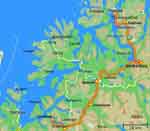 and Andselv, over the final southern
part of the long Balsfjorden up to
Nordkjosbotn. There we turned left and
proceeded to north, over the eastern shore of Balsfjorden, towards Tromsø,
with a strong wind again. It was not quite pleasant. We stopped in front of
a camp at the entrance to Ramfjorden, 30
km before Tromsø and there we took a proper shower (2.500 Italian liras per
person). In Norway it is possible to enter a camp without the vehicle, to
buy chips and have a shower. At the entrance to the camp there was, of
course, a guardian in his cabin who was chewing the dry cod. Close to him,
under the table, there was his dog and it was chewing, of course, the cod
fish. It had therefore, probably, such a marvellously thick and shiny hair!
and Andselv, over the final southern
part of the long Balsfjorden up to
Nordkjosbotn. There we turned left and
proceeded to north, over the eastern shore of Balsfjorden, towards Tromsø,
with a strong wind again. It was not quite pleasant. We stopped in front of
a camp at the entrance to Ramfjorden, 30
km before Tromsø and there we took a proper shower (2.500 Italian liras per
person). In Norway it is possible to enter a camp without the vehicle, to
buy chips and have a shower. At the entrance to the camp there was, of
course, a guardian in his cabin who was chewing the dry cod. Close to him,
under the table, there was his dog and it was chewing, of course, the cod
fish. It had therefore, probably, such a marvellously thick and shiny hair!
Refreshed and clean we continued our journey to Fagernes, where we turned to the left again. We arrived to Tromsø at about 2.30 p.m. (VIDEO 70), with light rain, over the long bridge over the fjord. It’s a nice little town, very tidy, full of people, but at 4.30 p.m., when the shops close, all becomes an empty place. In general, passing through inhabited places in Norway, and on the roads as well, one can see very few people.
We stayed overnight in the vicinity of the harbour on a plateau, 5 metres away from the sea shore. It was quiet and pleasant, far from the traffic. We had covered a long trip over not the best road and were tired due to the considerably stressed driving, made more difficult due to wind and rain. The mountain over which we had come was also rather foggy. We had dinner in a holy peace. I had tried to fish before retiring to bed, but nothing. How sad!
This time we passed the night very nicely, without wind, without rain and finally in a wonderful peace!
The 23rd Day – 27.06.1995 - Tuesday: Tromsø - Soleng – 194/6.377 km
The day was born with the half overcast sky, with rather plenty of sun, but cold and windy. We went to tour the town in the morning (VIDEO 71). Carla went to seek pendants for our children, Jasminka and Peter, but did not buy anything since everything was too expensive. The streets were rather full of people in spite of very cold and windy day. The weather was similar to ours in February, and not to the one in summer, but it appears that such are their summer temperatures and that the people are accustomed to such a climate. We saw a young and attractive girl in mini skirt and without stockings. Brrr, what a horror! We filmed with camera round the town, bought provisions and the paper " La Stampa" of Sunday (VIDEO 72). I heard two women to speak Croatian on the street, stopped and learned that they were Muslims, refugees from the Croatian part of Mostar town!
We moved back towards Nordkjosbotn at noon. Leaving the town we had passed over a big bridge and stopped close to the church, built in a modern style, from where there was a nice view of Tromsø. We continued over the E6, and in Nordkjosbotn we turned this time towards north.
We stopped at a nice
parking lot, next to the very Storfjorden,
a meter away from water. We had a splendid sunshine,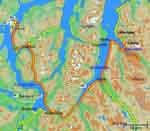 relatively warm. It was a great difference from the Tromsø weather, which is
closer to the ocean and exposed to cold air onrush. We were more protected,
no wind, the doldrums reigning there! We had lunch, I tried with fishing,
but it was hopeless. We moved on, stopped after some 20 km, tried once
again, but the fishes were ignoring us.
relatively warm. It was a great difference from the Tromsø weather, which is
closer to the ocean and exposed to cold air onrush. We were more protected,
no wind, the doldrums reigning there! We had lunch, I tried with fishing,
but it was hopeless. We moved on, stopped after some 20 km, tried once
again, but the fishes were ignoring us.
We stopped again at Odden, just behind a point at the entrance to Kåfjorden and decided to catch something, this time seriously. We left the camper on a small parking lot at a bend of the road and descended to the sea. Carla had found shells for the bait and this time it went better. We caught 4 saithes: 3 small ones and a big one (Carla’s) (VIDEO 73). Carla is filming catching fish with a video camera, but she turns the camera for 90 degrees!? She forgets that she is not working with a photo camera and the film is now rotated for 90 degrees! What a pity!
A camper arrived to the parking lot. A couple: He a Swiss from Basel, she a Nepalese, he about 65, she 30-35. She appeared to be a good fisherwoman. He was not leaving the camper at all, he was reading and she was fishing. It was the first time that we have seen how the fish is to be caught!! She was fishing with the blinker, a not with the float with bait. The blinker (probably of a lead alloy) imitates a small sardine (obtainable in various sizes and weights), painted in various colours and having in its tail a three point hook in form of a tricorn anchor. It should be thrown far away to 20-30 m distance, pulled back reeling the nylon line quickly and every while a jerk with the fishing rod is to be made. The fish jumps after the blinker and this is all! This is the secret of the rich catch. At the end she gave us her catch as present: a nice cod fish of more than 1 kilo and two nice saithes in addition. They eat big fish only and had the refrigerator full!!
We continued on and at a small waterfall next to the road we replenished our stores with clean and cool mountain water that a small brook brings down from a glacier (VIDEO 74). We stopped at the opposite shore of Kåfjorden at Soleng before Olderdalen and made camp for staying overnight at about 10.00 p.m. In between the road and the sea we found a big level ground, probably intended for construction of a petrol station or something similar, and here we got to build our camp. We hoped to see the midnight sun after the supper. The sun was still high above the horizon at 11.30 p.m., among the clouds, but then the sky got fully overcast and the spectacle was lost. And soon the rain started to be heard softly on the roof. The night passed otherwise peacefully and quietly, although we were not far away from the road. To our luck the traffic was very light.
The 24th Day – 28.06.1995 - Wednesday: Soleng - Langenes – 185 /6.562 km
We got up late in the
morning and departed under light rain towards the north. We passed
Olderdalen and
Langslett and stopped at the place of Nordreisa, where we bought
some food in a shop. We saw blinkers for fishing and bought two of them to
make a try. We moved on and made a stop on the parking lot of
Straumfjordnes. Carla was cooking the
lunch, while I have noticed that the fishes were jumping and that the see is
boiling. Due to fishes! It was just the time when the tide from the open
sea,
Reisafjorden,
was rushing into the bay
towards the narrow passage in Straumfjorden
creating rather strong currents there. A mass of fishes was coming with the
currents, chiefly saithes. We saw them also next to the shoreline swimming
in shoals and then they started to jump ever higher and the sea seamed to be
boiling really. We tried to fish with baits and caught with the great
difficulty jade however three saithes only.
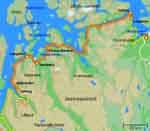 We
grasped that they are not interested for the bait, so we tried to put on the
blinkers and right away it went, although the blinkers were not those right
ones. But it was essential to throw far away and turn the reel, i.e. to pull
the blinker through the water towards the shore and the fishes jump then at
such type of bait. Silly ones! But inexperienced as we were, we had lost
both blinkers soon and the fishing was over. Namely, it is necessary to pull
constantly to avoid letting the blinker to fall on the seabed, since then it
gets trapped behind a stone and it’s no more. We managed to free the blinker
two times somehow, as this was near to us, and then the Carla’s one got
jammed and I intended to help her as a real gentleman letting my rod off and
jumped to help Carla. Of course, we did not manage to pull out Carla’s
blinker and mine fell in the meantime to the bottom and thus both were lost.
What stupid fellows we were. It was pity, irrespective the fact that the
catch was rather good already.
We
grasped that they are not interested for the bait, so we tried to put on the
blinkers and right away it went, although the blinkers were not those right
ones. But it was essential to throw far away and turn the reel, i.e. to pull
the blinker through the water towards the shore and the fishes jump then at
such type of bait. Silly ones! But inexperienced as we were, we had lost
both blinkers soon and the fishing was over. Namely, it is necessary to pull
constantly to avoid letting the blinker to fall on the seabed, since then it
gets trapped behind a stone and it’s no more. We managed to free the blinker
two times somehow, as this was near to us, and then the Carla’s one got
jammed and I intended to help her as a real gentleman letting my rod off and
jumped to help Carla. Of course, we did not manage to pull out Carla’s
blinker and mine fell in the meantime to the bottom and thus both were lost.
What stupid fellows we were. It was pity, irrespective the fact that the
catch was rather good already.
We moved towards the place of Alta, since the new change of the high and low tide was due for two hours only. During the ride we met for the first time the reindeers, at the beginning here and there single ones, among the birch trees, but later we saw whole droves on the mountain. In one place there were three droves of 50-60 animals each. A bus with Slovenians from Maribor reached as, too. During the trip the weather has improved (VIDEO 75).
We stopped at Langenes, in Altafjorden, 4 km past Toften, on a wild parking lot next to the road, as it was already late and one had to start thinking about sleeping. However, we wanted to fish more since the area seemed appropriate. We tried again in the old way, with baits, since we had no blinkers, and we caught 4-5 smaller fishes. About 10.00 p.m. a young Norwegian fellow arrived to fish, who told us that salmons were coming with the tide that evening and, when he saw our fishing gear, he added that nothing could be caught with it. He gave me as present a true blinker, such one as he was also using, while Carla, to counter, gave him a litre of wine, which is there very expensive. He told that soon his brother and father and one friend would come, that night was the true opportunity, passage of salmons was expected. I had watched him a bit throwing his blinker (even up to 50 m from ashore) and at the end I withdrew a little sideways, whereupon I started to “bathe” my blinker. After having thrown it for some ten times something rather big got hooked and, after a short fight, I pulled out a marvellous cod fish (torsk in Norwegian) weighing more than 1 kilo (57 cm long). Carla called from above, from the parking lot, to come to dinner, it was already 11.00 p.m., and I showed her my trophy with pride. Carla was enthusiastic and after the dinner wanted to go fishing again. The Norwegians abandoned the fishing having pulled out two (2) saithes only. It was midnight already, the weather was cloudy, and we did not see the midnight sun, pulled out another fish and about 1.30 a.m. we went to bed.
The 25th Day – 29.06.1995 - Thursday: Langenes - Rypefjord – 203/ 6.765 km
We got late out of bed, had breakfast and about 11.00 a.m. departed towards the place Alta. Before Alta we stopped in front of a museum and made a visit to see the drawings on rocks (cut in the stone) made 6.000 years ago. All cuttings are painted red, probably to become more visible, but one got the impression that someone is playing with visitors and collecting money (12.000 Italian liras per person). Notwithstanding this, they are probably the original ones (VIDEO 76).
After this we bought in Alta provisions, blinkers and diesel fuel and moved on. We had lunch after Alta in a bay behind the place Rafsbotn, on a secondary road to Russeluft. The water was not nice as usually, the see looked like a lake covered with algae having a strange yellow-brown colour. Carla was preparing the lunch and I used this break to try my luck. But the sea was too shallow (maybe this is why it looks unclean) and no tugs come from the water. After lunch the road led us over a desolate plateau in direction of Skaidi. Of a sudden, trees and greenery had disappeared, the landscape started to look like on a polar circle, but without snow. We had only a straight road ahead of us, without curves, leading slightly upwards or downwards, not a living soul for 50 km, tundra all around. At At Skaidi we deviated to the left towards Hammerfest hoping to see the midnight sun there (VIDEO 77).
At the place
Oldernes we broke out on the sea again.
Long the road we were looking for a fishing site, but everywhere
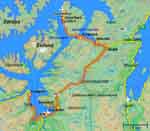 along
the coast there was a rather (two-three metres) wide layer of yellow, big
algae which was menacing to imprison the blinker when pulling it out of
water. It was also rather windy, but luckily it did not rain. Finally, at
the place Kvalsund, we reached the
wonderful bridge connecting the land with the
Kvaløya, the island on which Hammerfest is actually situated.
This strait is relatively narrow and is situated between two big fjords,
Sammelsundet and
Straumen. We had hoped that rather strong currents are created
there between the tides and that with the currents fishes were coming and…?
We decided to stop and to try.
along
the coast there was a rather (two-three metres) wide layer of yellow, big
algae which was menacing to imprison the blinker when pulling it out of
water. It was also rather windy, but luckily it did not rain. Finally, at
the place Kvalsund, we reached the
wonderful bridge connecting the land with the
Kvaløya, the island on which Hammerfest is actually situated.
This strait is relatively narrow and is situated between two big fjords,
Sammelsundet and
Straumen. We had hoped that rather strong currents are created
there between the tides and that with the currents fishes were coming and…?
We decided to stop and to try.
We passed with the camper under the bridge and stopped after some 200m (+). There were no wind and no algae either. We parked the camper and I hurled the blinker. In short time I pulled out 6 big saithes (from 0.50 to 0.75 kilo) and two smaller ones (VIDEO 78). It went like crazy. I stopped fishing, as Carla did not know what to do with the fish, our refrigerator is relatively small, has no proper space for fish respectively, and so, to the great regret, I had to stop. But it started to be chilly, it was however 8.30 p.m. already. That morning, at Alta, a drizzle persisted and it was cold, whereas in the afternoon it was windy and the wind has cooled down still further the already chilly air.
We packed our fishing gear and started over the bridge towards Hammerfest (VIDEO 79). We reached Rypefjord about 9.00 p.m. and parked next to a fishermen cottage. Two campers were already parked there, one from Pisa and one from Florence. I gave them as present two big saithes, so that we can fish tomorrow again. They were more than happy, but Carla protested violently, she did not believe “in the crazy luck I had that day”, while I was thinking that the strait was full of fishes and that there would be no problem to provide us with fishes again the next day.
For dinner we had the nice, super fresh fish, good wine and marvellous peace. The rain started again about midnight.
The 26th Day – 30.06.1995 - Friday: Rypefjord - Hammerfest - Skavika – 153/6.918 km
When we awoke in the morning we saw through the window a small drove of reindeers which were passing over the parking lot and grazing on its boundaries. After breakfast we departed for Hammerfest about 10.30 a.m. Hammerfest is a nice port town of a considerable importance for that territory and, at the same time, the most northern harbour of Norway. Entering the city we had noticed that many houses were of concrete and not of wood, what is normal for Norway. We learned later that during the WW2 the town had been destroyed by German army and that what we saw was the completely new town (VIDEO 80).
We bought some 20 picture post cards in Hammerfest, to send our greeting to all. We decided not to go to Nordkapp, since we were convinced that one goes there out of pure snobbism, so that one could say: We, too, have been there! We had seen the buses of "Neckermann" and similar tourist organisations which sped over the central road of Norway towards north with great inscriptions on the bus: Nordkapp. They had seen nothing of Norway, for 7-8 days there and back, but they have been to North Cape! Stupidity! And only for the small ferry at Nordkapp (return ticket) about DM200 and further DM50 for the asphalted plateau are to be paid. The clever Norwegians know how to collect money. And people tell that, beside the look at the midnight sun from the plateau 300 m high above the sea, there is actually nothing else. Well, there is a kiosk with souvenirs. Like that one at the Polar Circle, where Carla had insisted that that we leave the parking lot, because of the crowd. And to see the midnight sun is the matter of sheer luck, as there the fogs or freezing wind are frequent. Some people wait there even for three days – to see the midnight sun.
The w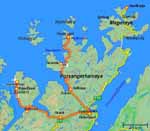 eather
is pissed off, slight drizzle persists, it is very cold, and when operating
the camera in Hammerfest my hands got frozen. And it’s the end of June,
summer started 10 days ago! An amazing and huge English sailing boat for
open sea was docked in the harbour. Some 30 m long or more, with a one very
high mast, super luxurious, all fittings huge and chromium plated. The sail
and the flocks (double) are for rolling. The transom can be opened and gives
access to a platform on which a motor boat is situated, which is stowed
inside the hull during the sailing. What a wonderful toy for deep pockets! I
could afford the luxury to film her with the camera (VIDEO
81).
eather
is pissed off, slight drizzle persists, it is very cold, and when operating
the camera in Hammerfest my hands got frozen. And it’s the end of June,
summer started 10 days ago! An amazing and huge English sailing boat for
open sea was docked in the harbour. Some 30 m long or more, with a one very
high mast, super luxurious, all fittings huge and chromium plated. The sail
and the flocks (double) are for rolling. The transom can be opened and gives
access to a platform on which a motor boat is situated, which is stowed
inside the hull during the sailing. What a wonderful toy for deep pockets! I
could afford the luxury to film her with the camera (VIDEO
81).
After touring Hammerfest we went again to the same place where we had been fishing the day before. Within an hour we caught some 15 saithes, big and extra big (some weighing more than 1 kilo), in total about 10 kilo of fish. And then we stopped, since where to put the fish. Carla caught the greatest saithe. It is hard to believe how many fishes there were in that strait. It appeared that we had just come across just at the right time. The currents due to the tides between one great and the other smaller fjord were visible and the sea started to boil again because of fishes, like two days ago at Straumfjordnes. However, the strait was there some thirty metres wide, and at that place it was at least two hundred wide and having, of course, far greater depths and greater fishes in them. The storms of seagulls rushed at the boiling sea and indulged in fish. Every time when we threw the blinker, we pulled it out with a hooked fish. We lost some of the fishes in the shallow water along the coast before having them pulled out. How many fishes there were, accounts the fact that we had pulled out at least 5 fishes hooked not for the mouth but at eye, belly and one at its tail. Namely, I used often to make a jerk when I was reeling the line up and so, when the blinker sped through the shoal, it got hold of whatever it met. This meant the shoal was enormous and dense. Carla protested: “This is not just!”, but when she started to catch, she pulled out a fish in the same manner. Regrettably, I lost again a wonderful blinker, since, when Carla started to pull and shout that something big had got hooked, I turned out again to be a gentleman, let go my rod and went to help Carla. She pulled out the greatest saithe and I lost the blinker! But never mind. It was an unforgettable event. Everything is documented in the film that Carla had shot, however with the camera turned around for 900 in her enthusiasm, so that the film is to be watched now with the head turned around for 900, too.
The greatest problem was what to do with so many fishes (VIDEO 82). To our regret we had to stop fishing when it was most enjoyable. People who dwell there fill up their freezer for the entire year in two-three of such days. Without great effort, without money, but with enjoyment! To our regret we had a tiny refrigerator which, however, operated there fantastically, probably because it was cold out there. The small compartment for freezing was OK, but sufficing for two kilos of fish, whereas the remaining ones can resist for at maximum two days, and we could not eat up 8 kg of fish during that period. This meant, we had to find again someone whom to give them as present.
After that marvellous fishing we moved towards east up to the place Skaidi and continued for Olderfjord. There we moved on towards north for Havøysund. It rained at the beginning but the weather was improving during the travel. We stopped on a lonely rest place above the sea right behind Selkopp about 7.00p.m., and started to write greeting cards bought that morning in Hammerfest. Nowhere a living soul, just a single car passed each twenty or so minutes. Outdoors, a cold wind was blowing, so we made hot tea and waited for the time to pass by and to get the sight of the midnight sun. It was semi overcast, but the sky smelled of clearing up and, indeed, the sun was penetrating more and more the clouds and the hopes were rising. The sun, on its trajectory from the west to the north (!) and east, was crossing the Revsbotn bay, which was in front of us, from left to right, and we realised that, even if the sky would become clear, we would not be in position to see it from that viewpoint at 0.00 hours at night. It would get behind the hill on our right. We had to find some place offering a broader view (VIDEO 83).
We departed therefore further to the north and about 9.30 p.m. arrived in Skavika, a little picturesque place in a beautiful bay. Fishing vessels, fishermen’s houses and the sun lit sea. Wonderful! We parked at a curve offering an amazing view through the window of our “restaurant” (VIDEO 84). Carla had prepared a nice evening meal of fish accompanied with nice wine. The landscape look was changing non-stop, becoming at times shadowed, at times sun lit, had rain illuminated by sun on a part of the bay, the contours of islands and hills changed in their intensity and colour shades in continuation. Rainbows, coloured clouds! Superb! We filmed all this, but the film will not show for sure all that beauty we had witnessed. The sun was shining at 11.30 p.m. like in Medulin at 7 o’clock in the evening, but than, regrettably, it was shaded by the clouds. At 11.50 p.m. it showed up briefly one more time through an opening between the clouds, and then the clouds prevailed and we did not see it any more (VIDEO 85). At 00.00 a.m. we had toasted nevertheless to our midnight sun with champagne and then moved from our parking lot to the quay-side in the small harbour (VIDEO 86). We enjoyed looking at the flock of ducks which were swimming and diving with their ducklings in the small harbour, admired the scenery and the play of colours which the sun was producing on the horizon. The seagulls were sleeping on a small beach notwithstanding the daytime period. It was rather cold and about 1.00 a.m. we went to bed. (We did not use our gas stove up to the present day). Just after we got into bed, the rain started to drum over the roof.
The 27th Day – 01.0719.95 - Saturday: Skavika - Havøysund - Ilfjord – 339/ 7.257 km
Again, we got up late, but this was not bothering us there. We were not interested at all what time was it and whether it was the time to get up. Often it happened, when we were travelling with the camper in afternoon hours, that it finally crossed our minds we could have our evening meal and, when looking at the watch, we found out that it was already 11 o’clock in the evening. The light is present all the time and the day and the night do not exist. We did always what we liked at that very instant, irrespective of the time the watch was showing.
Whe n
we had got up a light and cold drizzle was present. We moved further to the
north already at 11.30 a.m., in direction of
Havøysund, reaching it after an hour, over a relatively narrow
but in turn, with a view to the landscape, very interesting road (VIDEO
87). Before
Havøysund we saw on the road, that was at least ten metres above the sea
level, a lot of sea urchins crushed, of course, by the cars. We understood
later that they were being brought by the sea gulls from the sea during the
low tide. However, we did not come to the conclusion whether they are
dropping them onto the asphalt to get cracked, or just bring them only,
letting the crushing to by done by cars. Anyway, they have solved the
problem in general. We do not know the technology, but it works. Thus, the
road is thus full of killed sea urchins and the sea gulls are probably full.
n
we had got up a light and cold drizzle was present. We moved further to the
north already at 11.30 a.m., in direction of
Havøysund, reaching it after an hour, over a relatively narrow
but in turn, with a view to the landscape, very interesting road (VIDEO
87). Before
Havøysund we saw on the road, that was at least ten metres above the sea
level, a lot of sea urchins crushed, of course, by the cars. We understood
later that they were being brought by the sea gulls from the sea during the
low tide. However, we did not come to the conclusion whether they are
dropping them onto the asphalt to get cracked, or just bring them only,
letting the crushing to by done by cars. Anyway, they have solved the
problem in general. We do not know the technology, but it works. Thus, the
road is thus full of killed sea urchins and the sea gulls are probably full.
Havøysund is a small, nice fishermen settlement and, at the same time the most northern point of our journey. It is something more to the south than Nordkapp, but not much. The weather was without the rain, but cold. We posted our picture post cards at the mail office. About 4.00 p.m. we started towards the south, finally and for sure (VIDEO 88). We bypassed again Skavika and Olderfjord. The distance from Havøysund to Olderfjord is about 70 km and the traffic density in that part of Norway is as follows: when arriving by this road we have encountered five to six cars and one bus with tourists. When departing there was one bus more! One vehicle per every 10 kilometres in average! During winter (from October to March, and in 1993 it lasted up to the end of June) Havøysund can be reached or left by car only in a convoy behind the snow plough. In no case if it is snowing (VIDEO 89).
After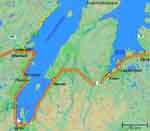 Olderfjord, from where a road leads to Nordkapp, situated from there only
100 km, which was, however, of no interest for us, we arrived in
Lakselv, onto the most southern point of
the Porsangerfjorden. In the parking lot
we found three Italian couples (with three campers) which had just arrived
from Finland, on their way to Nordkapp. We gave them 4 big
saithes, to their great pleasure, of course. And we got 3 big mushrooms
which they had picked up in Finland. They told that Finland is full of them
and that they could be found under every birch tree. Carla thought that
those were the Birkenröhrling (germ.)/Porcinello (ital.). But they let us
also know that Finland is full of mosquitoes, which don’t let you live.
Olderfjord, from where a road leads to Nordkapp, situated from there only
100 km, which was, however, of no interest for us, we arrived in
Lakselv, onto the most southern point of
the Porsangerfjorden. In the parking lot
we found three Italian couples (with three campers) which had just arrived
from Finland, on their way to Nordkapp. We gave them 4 big
saithes, to their great pleasure, of course. And we got 3 big mushrooms
which they had picked up in Finland. They told that Finland is full of them
and that they could be found under every birch tree. Carla thought that
those were the Birkenröhrling (germ.)/Porcinello (ital.). But they let us
also know that Finland is full of mosquitoes, which don’t let you live.
From Lakselv we moved on towards north, as the road to the south leads to Finland, and we had wanted to go first to the east, up to the Russian border at Kirkenes. We turned later to the east and on the 6o km long plateau, which we had crossed between the places of Borselv and Kunes, situated at the 150 m above sea level, we did not see a single tree. Sort of desert! As soon as one comes a little higher above the sea, the vegetation disappears! On the way to Ifjord we stopped at the place Landersfjord (in Laksfjorden) at a belvedere where Carle prepared a mushroom risotto and fried two big saithes for the evening meal. It was so nice to lick the fingers. Prior to the dinner I got down to the sea and threw the blinker for some ten times, but not a tug. Strange! We reached Ifjord about 11.00 p.m., where, in the bay, next to the road, we set our camp for that night. Nice weather had accompanied us from Olderfjord and it looked like we might enjoy nice weather the next day, too. It was a quiet and peaceful night, pleasant for sleeping.
The 28th Day – 02.07.1995 - Sunday: Ifjord - Tana bru – 221/7.478 km
We woke up about 7.00 a.m. with sun and clear sky, fell asleep again and about 9.30 a.m., when we awoke again, all was cloudy and it started even to rain. We got moving with sun and clouds at 11.15.a.m. We filled all our tanks with nice, fresh water from a mountain brook during that trip, and about 12.30 p.m., we broke out on the river Tana, at the place of Ruostefjelbma. We made a call (from a public phone) to our son Peter and talked to him.
After this we started over some narrow white road to north towards the estuary of Tana, intending to try fishing, but after some time that narrow road turned into a broad, stony goat track, so that only after several kilometres of wasteland we managed to turn the camper in direction backwards and moved on for the place Tana bru. This area is known after the manufacture of silver and gold jewellery, which is Carla just looking for. She would like to buy pendants for Jasmine and Peter (our daughter and son). But, it was Sunday and everything was closed. Well, tomorrow at 8.30 a.m.
We wanted nevertheless
to fish somewhere after lunch, so we moved towards
Varangerfjorden (in direction of Kirkenes).
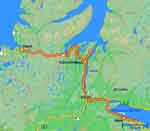 We
found some suitable shore only after 50 km, behind
Nyelv, at the southern coast of the fjord. When we arrived it
was the low tide and a belt three metres wide of algae separated us from the
sea and, of course, there was no fishing. Carla had found again four
(coloured) stones for her collection and then we returned to the road where
we left our camper. We picked up two retirees, husband and wife, from a
small house and brought them to the camper, to have with us some cheese and
a glass of wine, after what they invited us to their home to have coffee and
sweets. Nice people. He (probably a former skipper of some small fishing
boat) and his brother possessed there two small houses, one next to the
other, boats and nets and were living rather isolated from the world. There
were, within a circle of 300 m, another three houses, and then there was a
distance of 5 km to the first next house, and 25 km to the first shop. And
what when there is winter and the snow falls, and the night last nearly for
three months…? It appears that a small bus is organized which at intervals
brings the people from that settlement to the shopping centre (40 km), so
that they can buy plenty of provisions. Luckily, all of them have phones for
possible emergency, and the television for entertainment. They have deep
freezers situated in the shed, outside the house, and they keep their frozen
fish and meat there. To fill up the refrigerators with fish during summer
means no problem, we had seen how this is done at Hammerfest. If during
winter there is a black out due to stormy weather or blizzards, this means
no problem, as outside the refrigerator the temperature is minus 300
C!
We
found some suitable shore only after 50 km, behind
Nyelv, at the southern coast of the fjord. When we arrived it
was the low tide and a belt three metres wide of algae separated us from the
sea and, of course, there was no fishing. Carla had found again four
(coloured) stones for her collection and then we returned to the road where
we left our camper. We picked up two retirees, husband and wife, from a
small house and brought them to the camper, to have with us some cheese and
a glass of wine, after what they invited us to their home to have coffee and
sweets. Nice people. He (probably a former skipper of some small fishing
boat) and his brother possessed there two small houses, one next to the
other, boats and nets and were living rather isolated from the world. There
were, within a circle of 300 m, another three houses, and then there was a
distance of 5 km to the first next house, and 25 km to the first shop. And
what when there is winter and the snow falls, and the night last nearly for
three months…? It appears that a small bus is organized which at intervals
brings the people from that settlement to the shopping centre (40 km), so
that they can buy plenty of provisions. Luckily, all of them have phones for
possible emergency, and the television for entertainment. They have deep
freezers situated in the shed, outside the house, and they keep their frozen
fish and meat there. To fill up the refrigerators with fish during summer
means no problem, we had seen how this is done at Hammerfest. If during
winter there is a black out due to stormy weather or blizzards, this means
no problem, as outside the refrigerator the temperature is minus 300
C!
They informed us that the high tide maximum is at 8.30 p.m. (these information can be read every day in the newspapers and they cover various regions in Norway!) and that the fishing is promising. Thus, Carla and I, we moved out at 08.30 p.m. to fish. I threw for some 10 times the blinker, not even a tug, and the mosquitoes were attacking us incessantly, so that we had to literally flee from the sea side to the camper. We left the road leading up from the sea in a great haste rushing into the camper, succeeding to close the door quickly and to kill those two-three mosquitoes which managed to enter it together with us. It is unbelievable how many they were. What will be in Finland? To our luck we had liquored us well with Autan, so that we managed to pass without stings, but they had buzzed dangerously and insupportably around the nose and the ears.
We took our leave of Ragnauld and Anne-Lisa and started back to Tana bru, where we arrived about 11.30 p.m. with sun. We parked in front of the tourist office and filmed the midnight sun that peeped out through clouds at midnight. Carla baked the two last not deep frozen saithes that tasted super nice. Carla has become a real chef for preparing fish! Only the deep frozen saithes were left over in the freezer at that time, this meaning for only two, at maximum three evening meals. In Hammerfest we had thought that we would find fish in abundance for fishing, but there the things were not such as on the shores of the Atlantic, leaving us without fish at that time. We had to go fishing next day to make stores of fresh fish (?) for Finland.
The 29th Day – 03.07.1995 - Monday: Tana bru - Kirkenes – 193/7.671 km
We awoke in the morning with sunny weather, had breakfast and about 11.15 a.m., after having bought the pendants, departed for Kirkenes. We passed Gandvik and came out of the main road behind the place Bugøyfjord and reached the place Vaagi. There, we found a group of Finnish (6-8) which had come from Finland to fish there. They were familiar with the area and it was allegedly good. I had tried as well, tried to fish or was throwing the linker respectively, for half an hour, but not a single tug! The Finnish did not manage to catch anything either. It appeared that the Barents Sea could not be compared with the Atlantic of the two days ago even in the minimum sense, at least not there, at the bottom of the Varangerfjorden.
We moved on for
Neiden over the natural reserve Permafrost
where, on a parking lot, under a wonderful sunshine, Carla had prepared a nice
spaghetti dish with the sauce of tomatoes and olives! I intended to go down from
the road to the
ground being 6-7 metres below the road. But all this was a great swamp, I was
immediately attacked by mosquitoes and I fled heedlessly back to camper. One
cannot see the marsh character of the ground from the road, only here and there
some small lakes. We have learned the next day in Neiden, that this permafrost
is a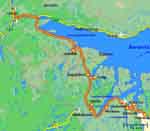 ctually
a huge, permanent block of ice which thaws away partially on its surface, down
to 2-3 m beneath its surface respectively, only during the summer, and freezes
again in autumn or during the winter. The surface of this rather great
permafrost is approx. 10 x 12 km (120 km2).
ctually
a huge, permanent block of ice which thaws away partially on its surface, down
to 2-3 m beneath its surface respectively, only during the summer, and freezes
again in autumn or during the winter. The surface of this rather great
permafrost is approx. 10 x 12 km (120 km2).
According to a Norwegian programme, it was foreseen that about 3 million seeds of all kind of cereals get stored in this permafrost on Spitsbergen islands. Those seeds would be preserved at such temperatures and, according to the statements of scientists, would be usable for cultivation also after several hundreds, if not after several thousands of years. To this purpose, close to the small town of Longyearbyen, a room having a special oval vault will be made in the wall of ice. Scientist believed that in case of a global catastrophe we would have a sort of the Noah’s Ark with the cereal seeds.
After lunch we moved on, stopped at marvellous waterfalls of Skoltefossen and filmed them. We continued for Kirkenes, stopped at Munknes, in Neidenfjorden, tried to fish but nothing again. We climbed the rocks, looked for better positions, but not a single tug again. We continued driving, bypassed Kirkenes and started in direction of Murmansk by the road 888. We reached the Russian border few kilometres behind the place Elevenes. We filmed the check point, Russian flags and about 7.p.m. returned to Straumen, in Langfjorden, in order to try fishing. In short time the high tide rushed through this bottle neck, a real river rapids were created, there was a multitude of fishermen, since this strait was advertised everywhere, all waited for that moment, started to fish and no one caught anything! I was throwing the blinker for an hour, got frozen, and as usual – wet underwear with the fishermen… ! A group of three was next to us, obviously experienced fishermen, with a mass of special blinkers and hooks, nothing. About 10.00 p.m. we arrived in Kirkenes and parked on a nice parking lot close to the very harbour. The weather deteriorated and dark clouds started to gather on the sky. I went to throw several times the blinker from the harbour breakwaters and managed to catch finally 2 small saithes. I threw one right away back into sea, as it was really small, while I brought the other one to Carla, to prepare it, when there was nothing better. Her comment: ”What shall I do with this little fish?” For dinner we ate the remnants of pasta sciutta, frankfurters and eggs. The fish was eaten by the sea gulls. And again the rain drummed over the roof at night.
Not a single day passed in Norway without rain. Out of 19 days in Norway we had at most 4 or 5 days with some sun, but therefore each day rain. But nevertheless, Norway is unforgettable!
The 30th Day – 04.07.1995 - Tuesday: Kirkenes (N) - Inari (SF) – 217/7.888 km
The morning was cloudy, the rain drizzled, air was rather chilly. We drank our tea and went into the place to buy food and picture post cards, to send greetings. We had arrived very far in the north and east, at only 150 km from Murmansk. We bought a very nice, fresh salmon for NOK 80 (24.000 Italian lira) in the market place. It was already degutted but integral with head. At 12.00 a.m. we moved finally by the E6 towards the south.
We turned to the left at
Neiden onto the 893 and after 10 km we crossed
the Norwegian border and entered Finland, where the 893 changes into the 971.
Not a living soul at the very border. If it were not for the sign boards and
flags, we would not even know that we were crossing the border. We saw the
customs house on one side, but we did not see a living person. After two km we
reached the checkpoint for the passport control, at least this was what was
written. One buil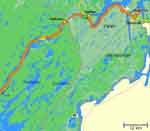 ding
again at soma 20 metres form the road, but not a living soul on the road, and no
one appeared behind the building. The green traffic light was on and we
proceeded. It was the same as on the border between Germany and France last
year, however, with the Norway being not in the European Union, whereas the
Finland is.
ding
again at soma 20 metres form the road, but not a living soul on the road, and no
one appeared behind the building. The green traffic light was on and we
proceeded. It was the same as on the border between Germany and France last
year, however, with the Norway being not in the European Union, whereas the
Finland is.
Right away after the border a big shopping centre, gas station. A tiny place Näätäma, was featuring the shopping centre, gas station and two more buildings. And this was all. But the business works. Everything is for approx. 20% cheaper than in Norway. The Norwegian buyers pay in NOK. And we bought the diesel oil in Norway because one human calf of a Finnish guy told me in Neiden that I would find the fuel in Inar only, i.e. after 200 km!
The look of the landscape in Finland commenced to change rather quickly, the mountains disappeared, pinewoods, short in height, appeared, and later birch trees and higher pines. We came across great stone fields. Great, grey stones with diameters 600-800 mm, the stones as if stowed one above the other, without a trace of any vegetation, cover areas between the road and the lake of the size of 100 x 50 m! We encountered a considerable number of these stone fields, but after 30-40 km sandy grounds with dunes appeared. And everywhere there was a lake next to another one. And forests, everywhere forests, which no one clears, with many broken, extremely dry trees, everywhere the wild untouched nature, except for our road passing through this wilderness and beauty.
Every so often a house appeared or several of them. At the main road, in front of the driveway leading to a house or several houses, which may be quite distant from the road, big roofed mail boxes were standing, their front open and a mesh on the bottom, where apparently the mailman leaves the mail. Perhaps takes it away as well, since a small lever with a circle, which can be in the lowered or lifted position, is the sign that there is or there is not the outgoing mail for the postman. We had met and filmed quite a number of reindeers which were wandering over the road or forest, not running away and not afraid of cars.
After some 40 km from border
we stopped at the shore of a lake and had half of the baked salmon for lunch. It
was very good, although I preferred our saithes. I tried surreptitiously
(without the fishing licence) to throw the blinker for several times into the
lake, but not a tug. Probably there were no chances with the blinker, but for
sure more patience, but also fewer mosquitoes are needed! After lunch we
continued always on towards south and soon the sky started to clear. After some
20 km we had sun and the clear sky. Miraculously, when we stopped we were not
attacked by the mosquitoes, although some of them buzzed by the ear. We passed
by the immense Inarijärvi Lake, the second
one in Finland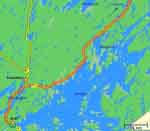 after the size, and finally, we come out at the place
Kaamanen on the main road E75 (4) leading from Lakselv (N) to
Rovaniemi and the Gulf of Bothnia.
after the size, and finally, we come out at the place
Kaamanen on the main road E75 (4) leading from Lakselv (N) to
Rovaniemi and the Gulf of Bothnia.
At about 6.30 p.m. we parked at the entrance to Inari, by the Sami Museum and there we were attacked by the mosquitoes. We wanted into the museum, which is in the open, in the wood, but already in front of a small window of the box office an anti-mosquito spiral was lit, so that they could not pay a visit to the cashier when he opens that window. I waved with my hands constantly around my head and fled to camper at last. I gave up the idea of visiting that museum. The wood was surely full of mosquitoes. After that we made a random walk in the centre and parked at the lake at the end. Regrettably, the weather got again worse and our wish to see the midnight sun did not come true. Carla had made for dinner a soup of the head and other remnants of salmon. Excellent! I have never liked the fish soup, but that one, of those fishes, was tasty like a best meat soup. To lick the fingers!
Before going to bed we examined everything in the camper whether a mosquito introduced itself covertly. We saw that kiosks sell posters with the inscription "Finland Air Force", below it a sketch of a big mosquito with the remark: "Dangerous for strangers only".
We went to sleep again after 12.00 p.m.
The 31st Day – 05.07.1995 - Wednesday: Inari (SF) - Kittila (SF) – 313/ 8.201 km
The morning with lot of wind, overcast, but dry. Carla had gone after breakfast to see the Sama Museum nevertheless. Brave, no doubt! I would not let me pull there even by a tractor. Perhaps in winter, when there are no mosquitoes probably. Carla had filmed the museum, in order that I could see something. She returned pleased, full of impression about the way of life when people lived as hunters. I wrote the diary and strolled by kiosks and shops that were selling souvenirs around the parking lot. We departed only at 0.30 p.m., always by the E75, under light rain which made us company the whole day. Sometimes heavily, sometimes lightly, but it had rained the whole day. Some 6 km before the place Ivalo we stopped on a parking lot (+) by the Inarijärvi Lake and Carle prepared a nice lunch of salmon. Fishing was not possible as it rained heavily. In Ivalo Carla went to a shop, under a heavy rain indeed, and bought up provisions.
The road after Ivalo to
Sodankylä was nice, new and broad. The
landscape is beautiful, but monotonous. We stopped at a souvenir-point being in
fact a tent in form of wigwam and bought two reindeer hides. We stopped on anoth er
place and picked up within ten minutes 2-3 kg of mushrooms,
Birkenröhrling (germ.)/Porcinello (ital.)
probably, although we were not too much sure about this, and whether they were
edible, either. Before Sodankylä we had at least some 10-15 km of the road under
construction, so that we had strummed to full extent on potholes over the
cracked, wet and muddy road following a thick line of cars. One could drive with
40-50 km/hour. In Sodankylä Carla went to the hospital and to a camp to ask
whether the mushrooms were comestible, but nobody new anything. It appears that
nobody eats mushrooms in Finland, and there are so many easily available. Maybe,
this was a possible consequence of Chernobyl?
er
place and picked up within ten minutes 2-3 kg of mushrooms,
Birkenröhrling (germ.)/Porcinello (ital.)
probably, although we were not too much sure about this, and whether they were
edible, either. Before Sodankylä we had at least some 10-15 km of the road under
construction, so that we had strummed to full extent on potholes over the
cracked, wet and muddy road following a thick line of cars. One could drive with
40-50 km/hour. In Sodankylä Carla went to the hospital and to a camp to ask
whether the mushrooms were comestible, but nobody new anything. It appears that
nobody eats mushrooms in Finland, and there are so many easily available. Maybe,
this was a possible consequence of Chernobyl?
About 7.00 o’clock p.m. we had departed from Sodankylä and turned onto the parallel road 80, relatively narrow, but very good and without traffic. Actually, we turned towards Sweden, although according to our original plan we were supposed to come down as low as up to Helsinki and then get transferred by a ferry to Sweden. But the mosquitoes in Finland have changed our plan and at that time we were fleeing from Finland. We saw yesterday, on a road in Inara, some people wearing on their heads tropical helmets from which e veil hung around the head. Against mosquitoes! Like beekeepers and researchers in the rain forest!
Monotonous landscape, light rain persisted. I drove with 100 km/hour, so we reached Kittilä quickly. On our way we asked again a woman, having a house there in the forest, whether she can tell us something about our mushrooms, but it looked like she had seen the mushrooms for the first time!! We parked in Kittilä on a spacious and marvellous but empty parking lot in front of the church, where there was only one camper from Karlsruhe. The German from the camper said to us that he knew the mushrooms well (should we trust him?), that those were Butterpilze¹) and that they were edible. Was he a possible good connoisseur? Carla was convinced that those were Birkenpilze, and I, too, have remembered (from Austria) the Butterpilze to be a bit different from those. At the end we brought a crucial decision: Carla was right, the mushrooms were edible. Carla prepared an excellent risotto and we gulped ourselves up fully. I went to bed with the hope that I would not have to get up for shitting and vomiting. We slept through a nice and peaceful night!
¹) In German: „butter mushrooms“
The 32nd Day – 06.07.1995 - Thursday: Kittilä (SF) - Laxforsen (S) – 303/8.504 km
We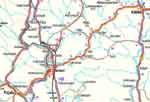 woke up, meaning we were alive. Nothing happened, the mushrooms were OK!
The sun had woken us, and it appeared at least, that the weather was
finally improving. We departed t 10.00 o’clock a.m., direction
Kolari. At first 3 km towards north by
the 79, and then we turned left onto the 939. A completely new road, not
even marked on the map, very nice and in a beautiful landscape. We
passed Ylläsjärvi, the ski centre.
The hill top is at the 757 m above sea level, it can be nicely seen from
the road, the upper hill half is without woods and already from afar the
skiing tracks (at that time without snow, of course) could be seen.
woke up, meaning we were alive. Nothing happened, the mushrooms were OK!
The sun had woken us, and it appeared at least, that the weather was
finally improving. We departed t 10.00 o’clock a.m., direction
Kolari. At first 3 km towards north by
the 79, and then we turned left onto the 939. A completely new road, not
even marked on the map, very nice and in a beautiful landscape. We
passed Ylläsjärvi, the ski centre.
The hill top is at the 757 m above sea level, it can be nicely seen from
the road, the upper hill half is without woods and already from afar the
skiing tracks (at that time without snow, of course) could be seen.
After this we came again across mushrooms in a pine wood, that time still nicer and still bigger. Carla picked up at least 3 kg within three minutes. There were also Birkenpilze, but there was another kind, too, of wonderful brown colour, big. Carla picked them up, but we were not sure whether they were comestible. We inquired in houses, at the pharmacy in Kolari, but nobody knew anything about the mushrooms and it really looked like that no one was eating the mushrooms there. We threw them away later finally, too risky.
At the
place Illäsjokisuu we got out onto
the E8 (21), turned after 1.5 km to right onto the 943 and arrived in
Kolari. Right after Kolari we turned again to right onto the 943,
crossed the bridge and entered the Sweden. And again, there was not a
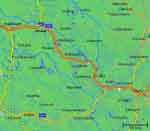 living
soul at the border. Were it not for the inscriptions on the boards, one
would not be able to tell that that was a border.
living
soul at the border. Were it not for the inscriptions on the boards, one
would not be able to tell that that was a border.
We continued over
the Swedish roads, being there not as good as the Finnish ones, which
(the latter ones) made us pleasantly surprised and which merit a maximum
mark. We passed the place Pajala,
where we came out onto the 99, after 6 km we turned left onto the 395
and continued on long the river Torneälven.
We stopped at a place and parked next the very river, to have lunch.
While Carla was preparing it, I went to the water to see how it looks
like, but again I had to flee because of unsupportable mosquitoes. It
was again a helter-skelter retreat to the camper. The wonderful river
can be watched through open windows, but only with the mosquito net
drawn down. Carla’s lunch was like in Hilton, mushroom risotto
(left-over from yesterday, but excellent), fried salmon with fresh
cabbage salad and, after that, pancakes with the elderberry jelly filled
with blueberries. For the Olympus! No fishing, since it was forbidden,
one must have a special licence which is expensive, i.e. which is very
expensive when nothing is caught. All this could be, though, swallowed
down, we were on a rather hidden place nevertheless, but the
mosquitoes!! Was the same destiny awaiting us in Sweden as in Finland?
After all, it was not that ba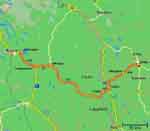 d
as we were told. It is essential that you never leave the car.?! We saw
later, on a rest place by the river, two persons eating at a wooden
table. That was normal. But they had on their heads hats and long veils
around the head! To go crazy!
d
as we were told. It is essential that you never leave the car.?! We saw
later, on a rest place by the river, two persons eating at a wooden
table. That was normal. But they had on their heads hats and long veils
around the head! To go crazy!
After lunch we
continued for the place Vittangi.
Again we came across on the road reconstruction and we had about 10 km
of cracked cobble road with 50 km/hour. We reached Vittangi at fair
weather. On the way through forests we were encountering everywhere
reindeers, which preferred walking over roads, as in the woods they
often have marshy ground. They are not at all afraid of the passing
cars. I made a try several times by stopping and coming out, with the
intention to get nearer to them, but then they fled. The drivers are
very much respecting them and when they see that a reindeer is on the
road or in the immediate vicinity of the road, they slow down right away
and drive practically at walking speed. Next to the shore of a river in
Vittangi we had coffee (we did not notice the presence of mosquitoes)
and decided to continue with the 45 in direction of
Kiruna. We came out at the place
Svappavaaru onto the E10 (Carla had
picked up on our way wonderful flowers, their blossoms like being of
cotton, the mullein, Wollblume in German), and then, far a change, the
rain came. We turned to the right 5 km before the place Kiruna for
Jukkasjärvi. This place is actually a
settlement of Laplanders, but there was nothing to see of the Lapp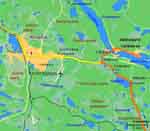 life. Just lovely houses, entrancing villas, huge tractors or
construction machines in front of the houses, a hotel, some 20 big
inflatable dinghies for rafting, cars, not a pedestrian at all.
life. Just lovely houses, entrancing villas, huge tractors or
construction machines in front of the houses, a hotel, some 20 big
inflatable dinghies for rafting, cars, not a pedestrian at all.
We did not find anything attractive for parking, so we returned back towards the main road (4-5 km) and set our camp at the bridge Laxforsen going over the small river Torneälven, between the lakes Oinakkajärvi and Sautusjärvi. It was a small nice parking lot, next to the shores of the river and lake, between pine trees, with a marvellous look at the water. Soon after our arrival the rain stopped and about 9.30 p.m. the sky was completely clear. There was also a multitude of fishermen (6-7) who were fishing from 7.30 p.m., when we had arrived, until after the midnight, but we did not notice a single catch. And they had admirable gear for all possible kinds of fishing and had tried all possible types of bait, but nothing.
At midnight we had the midnight sun in full splendour and we toasted to it with champagne. We were in our bunks about 1.00 a.m. The night was quiet, peaceful.
The 33rd Day – 07.07.1995 - Friday: Laxforsen (S) - Storforsen (S) – 368/8.872 km
We a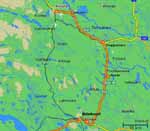 woke
in the morning with the sun. We had breakfast and went to
Kiruna. A huge iron ore mine, the world’s greatest
(after 1960. only the underground kind, and prior to that, an open pit, too.) In
wide underground
galleries an “underground Kiruna” exists, with offices, coffeehouses, mu
woke
in the morning with the sun. We had breakfast and went to
Kiruna. A huge iron ore mine, the world’s greatest
(after 1960. only the underground kind, and prior to that, an open pit, too.) In
wide underground
galleries an “underground Kiruna” exists, with offices, coffeehouses, mu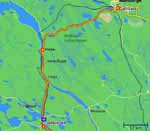 seums
and halls, with some 500 mine galleries descending up to 300 m under the sea
level.
seums
and halls, with some 500 mine galleries descending up to 300 m under the sea
level.
The town itself was boring, maybe ugly, without impressions. Low buildings long the streets. The town hall, quoted in the Bedeker as something special, has an interesting tower with an artistic iron structure, which had offered us a small, nice concert with its ringing of bells at noon. We visited also a very nice church. A very interesting structure covered on the roof and over outside lateral walls only with wooden tiles painted red, so that it looked from a small distance like being lined with bricks. On the altar there was an artistic picture of the nature with sun, without God and saints images, without gold and silver. It was simple, but very lovely, sheer and full of taste.
Carla tried again to find silver presents, but they were incomparably more deer there than in Tana, in Finland.
We depa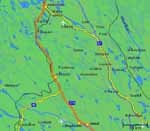 rted
from Kiruna only at1.00 p.m. over the E10, under sun, and arrived over
Svappavaara to Skaulo,
where we made a stop at the shore of a lake and had lunch. Carla prepared nice
pasta alla bolognese, great. We passed Gällivare
where we turned onto the road 45. We stopped two times to buy reindeer hides,
but this was two time more expensive there than in Finland, so we gave up. We
rted
from Kiruna only at1.00 p.m. over the E10, under sun, and arrived over
Svappavaara to Skaulo,
where we made a stop at the shore of a lake and had lunch. Carla prepared nice
pasta alla bolognese, great. We passed Gällivare
where we turned onto the road 45. We stopped two times to buy reindeer hides,
but this was two time more expensive there than in Finland, so we gave up. We
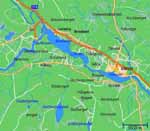 did
not see, regrettably, anything of the Lapps and their way of life, although
Carla had expected to see
something just there. Before
Porjus we came across on the road
reconstruction works again and swallowed down 20 km of cobbles. The rain
accompanied us from Porjus. Carla had discovered and bought on a stand by the
road a smoked trout. After that we passed Jokkmokk
and Kåbdalis. At Jokkmokk we crossed again
the polar circle, this time on our return trip. It was at the shore of a lake,
by a forest, under rain, but without snow and wasteland like when departing.
After Kåbdalis we turned onto the 374 and after some 40 km we reached the
Storforsen waterfalls area.
did
not see, regrettably, anything of the Lapps and their way of life, although
Carla had expected to see
something just there. Before
Porjus we came across on the road
reconstruction works again and swallowed down 20 km of cobbles. The rain
accompanied us from Porjus. Carla had discovered and bought on a stand by the
road a smoked trout. After that we passed Jokkmokk
and Kåbdalis. At Jokkmokk we crossed again
the polar circle, this time on our return trip. It was at the shore of a lake,
by a forest, under rain, but without snow and wasteland like when departing.
After Kåbdalis we turned onto the 374 and after some 40 km we reached the
Storforsen waterfalls area.
We
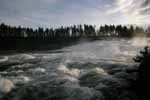 arrived
on the very Storforsen waterfalls at about 5.20 p.m., when the rain stopped to
our luck. We could tour these waterfalls at ease, these waterfalls being half
waterfalls and half huge rapids. The respective length is about 500 m with a
total drop of some 50 m. We did not film, since it was overcast, leaving this
for the next day (hoping for the sun), however, the impression was
extraordinary. Those immense quantities of water which are speeding down hill
(they are not falling),
give impression of grandiose power, of something supernatural. When looking at
this, a person remains fascinated by this natural beauty.
arrived
on the very Storforsen waterfalls at about 5.20 p.m., when the rain stopped to
our luck. We could tour these waterfalls at ease, these waterfalls being half
waterfalls and half huge rapids. The respective length is about 500 m with a
total drop of some 50 m. We did not film, since it was overcast, leaving this
for the next day (hoping for the sun), however, the impression was
extraordinary. Those immense quantities of water which are speeding down hill
(they are not falling),
give impression of grandiose power, of something supernatural. When looking at
this, a person remains fascinated by this natural beauty.
After the waterfalls we
moved on for Vidsel, hoping that we would
find somewhere water, because all our water reservoirs were just completely
empty. Regrettably, there were no mountains, and the mountain small brooks with
clean and potable water either, like in Norway, where we had replenished
ourselves as back as before Tana, this
 being
5 days ago already. We had watched, during the whole trip that day, whether we
would see some public fountain or something similar, to take the water, but
nowhere not a trace of it. And in Vidsel everything was desolate and closed. We
were forced to return towards the waterfalls and to get into the camp. After
all, we had to shower and to wash the hair. The camp was splendid, the price for
both of us SKr75 (DM15) only, this price comprising: water, showering, electric
power supply (which we did not need since we had the solar cells for charging
the batteries). It comprised also a kitchen for possible cooking (we had our
own, as well), laundry with washing machines, drying and ironing of he laundry.
However, Carla did not find our detergent for laundering, she would have to buy
it the next day.
being
5 days ago already. We had watched, during the whole trip that day, whether we
would see some public fountain or something similar, to take the water, but
nowhere not a trace of it. And in Vidsel everything was desolate and closed. We
were forced to return towards the waterfalls and to get into the camp. After
all, we had to shower and to wash the hair. The camp was splendid, the price for
both of us SKr75 (DM15) only, this price comprising: water, showering, electric
power supply (which we did not need since we had the solar cells for charging
the batteries). It comprised also a kitchen for possible cooking (we had our
own, as well), laundry with washing machines, drying and ironing of he laundry.
However, Carla did not find our detergent for laundering, she would have to buy
it the next day.
As to the parking, you park wherever you wish, either on the green grass at the foot of the waterfall with a great look at the waterfall being at a distance of 500m, or at the river or this small lake. We had a nice dinner. Carla had her smoked trout, while I had pasta and hot dogs. After that followed the showering and washing, filling of the reservoirs with water and about 11.00 p.m. we were in bed. A wonderful quiet night ensued, with a light noise of the, luckily, distant waterfall.
The 34th Day – 0 8.07.1995 - Saturday: Storforsen (S) - Bjuröklubb (S) – 257/ 9.129 km
A sunny morning awaited us again. Carla carried out one more detailed search of all closets and found finally the detergent, the one for hand washing of laundry, which is in line with the camper practice. She soaked the dirty laundry, we prepared the breakfast and after it we started through the wood to the waterfalls on foot. That day they were sun lit and we made at least 20 minutes of film. Wonderful, gorgeous, worth to be seen. Unforgettable! We returned to the camp, had pasta and dry beans (very nice) for lunch and after that Carla washed and dried the laundry. Thanks to the machinery, it went very quickly!
At 3.4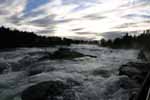 5
p.m. we started to see the Fällforsen, also
gorgeous waterfalls, but we did not manage to find the access road and finally
we gave up the search. We passed Ålvsbyn and
continued all the
5
p.m. we started to see the Fällforsen, also
gorgeous waterfalls, but we did not manage to find the access road and finally
we gave up the search. We passed Ålvsbyn and
continued all the
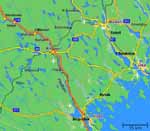 time
over the 374, for Piteå, where we came out
on the E4, in Gulf of Bothnia, all the time at nice weather. There, we turned
right to south. We tried several times to reach the very sea shore for possible
fishing. But the main road is relatively far away from the sea, whereas the
roads leading to the sea are very narrow, often non-asphalted and ending in
front of houses which have privatized the coast. And to park the camper in front
of someone windows is not nice. We stopped at Byske,
parked next to the beach at the entrance to a camp, which was totally chock full
with trailers, like tinned sardines. Several trailers queued in front of the
entrance waiting that a lot gets free and to enter the camp. At 7.00 p.m. some
children in bathing suits were chasing each other under a rather chilly wind,
descending by a water slide into water, wading at knee high sea and sprinkling
each other. The adults dressed, some in pullovers, and some in t-shirts.
Depending to their liking!
time
over the 374, for Piteå, where we came out
on the E4, in Gulf of Bothnia, all the time at nice weather. There, we turned
right to south. We tried several times to reach the very sea shore for possible
fishing. But the main road is relatively far away from the sea, whereas the
roads leading to the sea are very narrow, often non-asphalted and ending in
front of houses which have privatized the coast. And to park the camper in front
of someone windows is not nice. We stopped at Byske,
parked next to the beach at the entrance to a camp, which was totally chock full
with trailers, like tinned sardines. Several trailers queued in front of the
entrance waiting that a lot gets free and to enter the camp. At 7.00 p.m. some
children in bathing suits were chasing each other under a rather chilly wind,
descending by a water slide into water, wading at knee high sea and sprinkling
each other. The adults dressed, some in pullovers, and some in t-shirts.
Depending to their liking!
We moved on. The rain caught
us in the place Skellefteå again. We
continued to the place of Bureå, where we
tried to find a parking next to the sea, but repeatedly with no success. We left
there the E4 and started by small secondary roads towards the place
Burvik, hoping it were at the sea. At least it
looked so according to our maps. We had in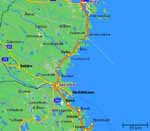 mind to find some little fishermen’s settlement, such as can be found in
thousands in Norway. Nothing, though. Burvik is situated at a distance of a
kilometre from the sea! On our way through a forest we came across a huge elk
female, which got scared end fled into the wood, so that we did not manage
mind to find some little fishermen’s settlement, such as can be found in
thousands in Norway. Nothing, though. Burvik is situated at a distance of a
kilometre from the sea! On our way through a forest we came across a huge elk
female, which got scared end fled into the wood, so that we did not manage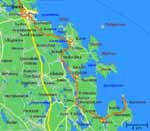 to film her. But it was dark already, though.
to film her. But it was dark already, though.
Over the places Risböle and Bjurön we reached finally the Bjuröklubb point, in a small National Park, where the road terminated, too. We found there, on a small terminal turning site next to the very sea, a parked camper from Hamburg. With a great look at the sea and in the company of the little three year old Nora (from Hamburg), Carla prepared a nice spaghetti dish accompanied by beer! When the rain finally stopped, we started about 11.00 p.m. o’clock through the pine wood towards the hill top, up to the light house. Far away, very far in the north, a long, narrowly lit streak could be seen, in reality the sun lit sky that was painted by wonderful colours: from gold yellow to light pink, with small illuminated cloudlets. Amazing, especially at 11.30 p.m.! The sun could not be seen, we were under the polar circle. With us, on Bjuröklubb, it was rather dark. But we saw that there was the day in the north!
At 0.00 a.m. I managed to catch on the radio, after three full weeks, the Italian RAI station and its Radio news and heard as D’Alema and Prodi shitted over Berlusconi. They didn’t know better! At 0.30 a.m. we turned finally the lights off.
The 35th Day – 09.07.1995 - Sunday: Bjüroklubb (S) - Köpmanholmen (S) – 288/9.417 km
Sun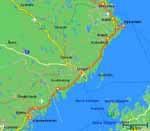 in the morning, but with pretty much of wind. The gulf was choppy with waves and
full of white crests. After breakfast we put our fishing rods into rucksacks and
started through the wood, over the hill, to the other side of the peninsula. A
short trip under sun and we arrived at the open sea facing Finland. It was a
shore with boulders, rounded, with smooth faces, same great rounded stones in
the sea, not a trace of algae. The whole coast of Norway is covered with a 3 m
wide belt of algae, which during the low tide remains outside the sea and to
reach the very sea, one has to cross this wet, slippery and sinking strip. There
was not a single algae, there in Finland. But, therefore, not a trace of fish in
the sea, either. I was throwing the hook for an hour, changing the position, but
not a single tug. It was like in a bath tub, empty.
in the morning, but with pretty much of wind. The gulf was choppy with waves and
full of white crests. After breakfast we put our fishing rods into rucksacks and
started through the wood, over the hill, to the other side of the peninsula. A
short trip under sun and we arrived at the open sea facing Finland. It was a
shore with boulders, rounded, with smooth faces, same great rounded stones in
the sea, not a trace of algae. The whole coast of Norway is covered with a 3 m
wide belt of algae, which during the low tide remains outside the sea and to
reach the very sea, one has to cross this wet, slippery and sinking strip. There
was not a single algae, there in Finland. But, therefore, not a trace of fish in
the sea, either. I was throwing the hook for an hour, changing the position, but
not a single tug. It was like in a bath tub, empty.
Returning back we toured the whole peninsula walking by the seaside, climbing the rocks, and finally we reached our camper. It was a nice tour with some mountaineering and jumping from a stone to another, the same being rather big and over which you cannot walk. Carla could not resist her passion to pick up stones for her collection in San Maurizio and she found two nice ones coloured pink (basalt), each having nearly 3 kg. Of course, they had to be carried in hand all the way jumping from a boulder to the other one. Dangerous! However, it was a nice and pleasant excursion.
We move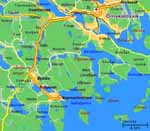 d
on finally at 2.00 p.m. over the shortest way and came again onto the E4 and
took the direction
d
on finally at 2.00 p.m. over the shortest way and came again onto the E4 and
took the direction
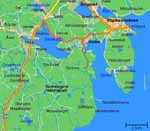 towards
south. We stopped at a lake where, in stead of lunch, we had coffee with sweets
and fed the
pigeons, which feature a black head there. We passed the places
Ånäset,
Umeå,
Nordmaling,
Örnsköldsvik and in the place Bjästa
we turned left, abandoned the E15 and at 7.00 p.m. reached the place
Köpmanholmen. It is a wonderful small bay, with
a large car parking lot for tourists, which depart from there for the local
isles. Fortunately, these are tourists indeed, leaving the cars there for longer
time, so that there is no traffic and noise.
towards
south. We stopped at a lake where, in stead of lunch, we had coffee with sweets
and fed the
pigeons, which feature a black head there. We passed the places
Ånäset,
Umeå,
Nordmaling,
Örnsköldsvik and in the place Bjästa
we turned left, abandoned the E15 and at 7.00 p.m. reached the place
Köpmanholmen. It is a wonderful small bay, with
a large car parking lot for tourists, which depart from there for the local
isles. Fortunately, these are tourists indeed, leaving the cars there for longer
time, so that there is no traffic and noise.
We took 4 saithes out from the freezer and Carla prepared a nice dinner. We didn’t have the green salad, but excellent dry beans salad instead. I tried to catch something as well there, from the quay wall, but not a tug there, either. Where were those wonderful times of Norway, when we did not know what to do with fish?
We decided not to continue towards south from Stockholm no longer, but to get directly through to the west, towards Norway, up to somewhere under Oslo and to try to fish there. That Gulf of Bothnia is sterile. At 11.00 p.m. we were in bed.
The 36th Day - 10.07.1995 - Monday: Köpmanholmen (S) - Alnön (S) – 188/9.605 km
We
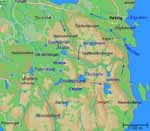 had
sun again. We saw the ferry with the passengers off in the port that morning and
then we went with the camper to the National Park of
Skuleskogens at 10 a.m., we put on our mountaineering shoes and went
for strolling. The park is left over to the nature and its laws. Nothing gets
touched, eve
had
sun again. We saw the ferry with the passengers off in the port that morning and
then we went with the camper to the National Park of
Skuleskogens at 10 a.m., we put on our mountaineering shoes and went
for strolling. The park is left over to the nature and its laws. Nothing gets
touched, eve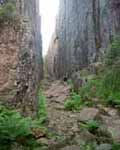 rything
grows, everything comes down and everything dies by itself. And that what is
fallen, remains down, too. The exception is the walking paths and the bridges
over brooks or swampy grounds.
rything
grows, everything comes down and everything dies by itself. And that what is
fallen, remains down, too. The exception is the walking paths and the bridges
over brooks or swampy grounds.
We went to the canyon of Slattdalskrevan situated below the top of a hill, actually we climbed over rocks to reach it. The canyon is very nice, about 200 m long, about 45 m deep/high and 6-8 m wide. In the foot of this hill there are everywhere small and beautiful lakes. From top of the hill a magnificent look opens at the lakes, sea shore and the sea with the archipelago. There, atop a rock, we had our lunch and then returned by a different way, descending through a neck-breaking steep canyon, reached a wasteland and a virgin rainforest and finally found the right way and at 6.00 p.m. we were in the camper. We drank with enjoyment some nice coffee and afterwards started by the E4 further on to the south.
At the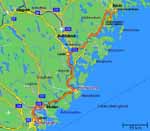 place Lunde, just after the bridge over the
Ågermanälven fjord, we descended to the seaside
place Lunde, just after the bridge over the
Ågermanälven fjord, we descended to the seaside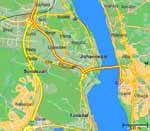 where, from an abandoned quay wall, I tried my luck. Nothing again! Carla, too,
tried to fish there, but after having thrown the blinker for several times, she
hooked the bottom and remained without the blinker. It was a pity and
disappointment. We continued on over Härnösand
and arrived in front of the town of Sundsvall
(the big industrial centre in Sweden), where we turned over a big bridge to the
island of Alnön and found, right under the
bridge, a small sailing boat harbour, where we parked. For dinner we had the
string bean soup and cold salami delicatessen accompanied by a nice cold beer. I
tried again to fish prior to the dinner, but not even an “f” of the fishing. The
night passed in a wonderful peace.
where, from an abandoned quay wall, I tried my luck. Nothing again! Carla, too,
tried to fish there, but after having thrown the blinker for several times, she
hooked the bottom and remained without the blinker. It was a pity and
disappointment. We continued on over Härnösand
and arrived in front of the town of Sundsvall
(the big industrial centre in Sweden), where we turned over a big bridge to the
island of Alnön and found, right under the
bridge, a small sailing boat harbour, where we parked. For dinner we had the
string bean soup and cold salami delicatessen accompanied by a nice cold beer. I
tried again to fish prior to the dinner, but not even an “f” of the fishing. The
night passed in a wonderful peace.
_____________________
NB: Several years after this journey of ours, a new E4 road was built passing something more to the south. The old one, over the bridge at Lunde, has become the 332. This change is entered into the enclosed map.
The 37th Day – 11.07.1995 - Tuesday: Alnön (S) - Stockholm (S) – 453/10.058 km
We had a nice, sunny and
warm day again. It looked like we had left the summer winter behind in Koruna.
We came from Alvik onto the E4 and over
Sundsvall, Hudiksvall
and Söderhamn arrived to
Norrsundet about 2.00 p.m. The road was good,
but with lot of traffic. Nice landscapes, but only for the picture post cards,
since all of them are the same. Nice valleys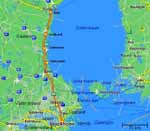 with lovely places and the church belfry, green meadows. It becomes boring after
some time. Not like in Norway, where after each point there was a new image, a
new, different fjord, lake or waterfall, the amazing, raw, untouched nature! In
Norrsundet Carla bought a nice fish, resembling trout or bass, for SKr23. It is
called sid there, and according to the vocabulary it was a herring. It
weighed about 600 g. Carla fried it and it was delicious. We
parked at the end of a small harbour, nearly at the way out from the small bay,
and there Carla prepared the lunch. It was lovely sunny and very warm. I had
prepared the hooks and that time, Carla and I caught on the bait, not with the
blinker, 4 smaller fishes, however very nice, I did not know of what species.
They would be for the lunch the next day
with lovely places and the church belfry, green meadows. It becomes boring after
some time. Not like in Norway, where after each point there was a new image, a
new, different fjord, lake or waterfall, the amazing, raw, untouched nature! In
Norrsundet Carla bought a nice fish, resembling trout or bass, for SKr23. It is
called sid there, and according to the vocabulary it was a herring. It
weighed about 600 g. Carla fried it and it was delicious. We
parked at the end of a small harbour, nearly at the way out from the small bay,
and there Carla prepared the lunch. It was lovely sunny and very warm. I had
prepared the hooks and that time, Carla and I caught on the bait, not with the
blinker, 4 smaller fishes, however very nice, I did not know of what species.
They would be for the lunch the next day
We continued our trip at
4.45 p.m. and arrived in the town of Uppsala
(the ambient temperature being
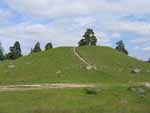 there
240C!!), at about 8.00 p.m. Prior to Uppsala we visited the more than
1.500 years old royal tombs, and in Uppsala we went around the astonishing
cathedral, thus seeing it from outside only (regrettably, it was already
closed). A walk through Uppsala followed, and about 9.30 p.m. we started our way
to Stockholm. To tell the truth, it was after a short argument, since Carla
wanted to stroll through the town still more, while I was in haste for
Stockholm, as it was late. We had some further
80 km to Stockholm, and I was also tired due to the already long lasting driving
of that day (400 km). Finally, we arrived to Stockholm (always by the E4) at
about 11.00 p.m. The greatest surprise was in the fact that no parking was
allowed overnight in the whole town, but only on very expensive parking grounds.
At day time SKr15/hour, at night time SKr7/hour, meaning SKr250/day = 55.000
Italian Liras. After a shorter roaming over the centre we came across some green
belt in the west side of the town and found there, below the TV/radio tower (Kaknästorg),
a parking lot without limitations and without charge, where we slept during the
night. To tell the truth, it was on a little sloped ground, but quiet. It was
without the city noise and traffic.
there
240C!!), at about 8.00 p.m. Prior to Uppsala we visited the more than
1.500 years old royal tombs, and in Uppsala we went around the astonishing
cathedral, thus seeing it from outside only (regrettably, it was already
closed). A walk through Uppsala followed, and about 9.30 p.m. we started our way
to Stockholm. To tell the truth, it was after a short argument, since Carla
wanted to stroll through the town still more, while I was in haste for
Stockholm, as it was late. We had some further
80 km to Stockholm, and I was also tired due to the already long lasting driving
of that day (400 km). Finally, we arrived to Stockholm (always by the E4) at
about 11.00 p.m. The greatest surprise was in the fact that no parking was
allowed overnight in the whole town, but only on very expensive parking grounds.
At day time SKr15/hour, at night time SKr7/hour, meaning SKr250/day = 55.000
Italian Liras. After a shorter roaming over the centre we came across some green
belt in the west side of the town and found there, below the TV/radio tower (Kaknästorg),
a parking lot without limitations and without charge, where we slept during the
night. To tell the truth, it was on a little sloped ground, but quiet. It was
without the city noise and traffic.
The 38th Day – 12.07.1995 - Wednesday: Stockholm (S) - Turinge (S) – 65/10.123 km
That nice, sunny and warm day we utilized to tour Stockholm. We departed in the morning, about 10.00 a.m., with the camper to the town, but during the ride an extraordinary idea crossed the mind of Carla – to tour the town by bicycles. We returned to our parking lot, lowered down the bicycles from the camper for the first time after 37 days, carried out a great dusting off and cleaning of all the nasty dirt of the journey made. The dust was like glued onto the bikes, we had to peel it off by a wet rag.
Stockholm is a gorgeous
city, it is called the Venice of the North, I would add, a much, much prettier
than Venice. Venice is a town of the fairy tale, medieval, as if created for
tourism, for watching, but in which I would not wish to live. Stockholm is a
marvellous place and it is the happy one who lives in it. It is built at a lake
and at the seaside, it’s full of ships,
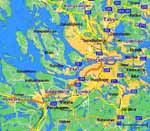 small
and large, both lake- and seaworthy, sailing boats and kayaks that cross through
it, and it is full of clean channels. People fish from bridges or from the shore
in front of the Royal Palace! It is full of wonderful streets, restaurants and
shops, people, tourists, cars, but it is clean and full of greenery. There are
paths for bicycles everywhere. Carla and I, we visited much of this in the town,
actually everything what was of interest for us, we did not get tired, but if on
foot, we would have lost both our breaths and our legs. Riding the bicycles? It
was a children’s play!
small
and large, both lake- and seaworthy, sailing boats and kayaks that cross through
it, and it is full of clean channels. People fish from bridges or from the shore
in front of the Royal Palace! It is full of wonderful streets, restaurants and
shops, people, tourists, cars, but it is clean and full of greenery. There are
paths for bicycles everywhere. Carla and I, we visited much of this in the town,
actually everything what was of interest for us, we did not get tired, but if on
foot, we would have lost both our breaths and our legs. Riding the bicycles? It
was a children’s play!
We returned about 2.30 p.m. to have lunch. Carla prepared fishes which we caught the previous day. Very nice! Carla insisted to see the museum of modern arts and after the lunch she went by bicycle into the town, whereas I had a good period of sleep on the sofa. She returned about 6 o’clock p.m., since she had found out that the museum was no longer there, where it was supposed to be according to the maps. It was moved on another place. At the end, we established on the map, that Carla had gone on a wrong island and that the museum could not be found there either.
After a cold dinner we moved with the camper into the town about 9.00 p.m., parked in a side street and went to tour the evening Stockholm. At the beginning we had still sun, but about 11.00 p.m. it got dark nevertheless. All restaurants do have terraces facing streets, the streets are relatively broad and everything is full of people. Chiefly the young ones (90%), very noisy and in great mood! Beer is drunk in general in large quantities. The atmosphere was very pleasant. On a sidewalk, a guy was playing with the trumpet some modern music, very nice!
About 11.30 p.m. we started with the camper towards west and we did have troubles until we found the motor way for Södertälje. There were many road signs for our road E4 and E20, but we did not know whether these signs could lead towards west in direction of Göteborg or back to Uppsala, both motor ways being marked with E4. Finally we managed to find our way out and arrived over the E20 into the tiny place Turinge, by Nykvarn, at 0.30 a.m., where we found a peaceful corner in front of the village church and went right away to bed.
The 39th Day – 13.07.1995 - Thursday: Turinge (S) - Grebbestad (S) – 505/10.628 km
A sunny morning woke us
again and after breakfast, already at 9.00 a-m. (!!), we started by the E20
towards the west coast
of Sweden. We decided to arrive as far as possible that day, if possible to
reach the sea, considering that
Sw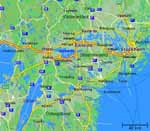 eden
has nothing to show in spite of being rich with woods and green meadows, lakes,
but not with rivers. After Eskilstuna we
turned to the left at the place Kungsör onto
the road 56, directly to the south, in direction of a huge lake of
Hjälmaren,
stopped at the crossing of the road over the lake (Hjälmare
sund), and tried to fish a little. (It is possible to fish on many lakes
in Sweden without a particular licence). I managed to catch within two hours
just two (!) quite small fishes, although huge shoals wer
eden
has nothing to show in spite of being rich with woods and green meadows, lakes,
but not with rivers. After Eskilstuna we
turned to the left at the place Kungsör onto
the road 56, directly to the south, in direction of a huge lake of
Hjälmaren,
stopped at the crossing of the road over the lake (Hjälmare
sund), and tried to fish a little. (It is possible to fish on many lakes
in Sweden without a particular licence). I managed to catch within two hours
just two (!) quite small fishes, although huge shoals wer e
under the bridge which were coming to the bait, sniffing it, but did not want to
bite.
e
under the bridge which were coming to the bait, sniffing it, but did not want to
bite.
After lunch (dry beans and green salad), we departed to continue on without stopping, turned to the right at the place Ås onto the road 52, reaching afterwards, over Odensbacken (a very nice warehouse, there), the place Örebro. From there we came out onto the E18 and proceeded through Karlskoga, Karlstad, Grums and Segmon, where we turned onto the 45 for Säffle and Åmål, turning there again to right onto the 164 for Billingsfors, Ed, Östad and Tanumshede and arrived finally, from the 163 in the early evening, (travelling thus not the shortest way) to Grebbestad at the shores of Skaggerak. Some 30 km before Grebbestad, the wonderful sunny weather, that was present long the whole trip, deteriorated and clouds appeared, but to our luck, not the rain. Grebbestad is a small fishermen’s settlement with a great sport marina that was full of the passing yachts. It showed signs of being busy like a beehive.
We parked on a great parking lot in front of the marina and managed to read, in the darkness, the inscription on a board: For campers and trailers parking time maximum 4 hours. After the dinner (nice spinach and eggs) we let us into beds at about 12.00 p.m.
The 40th Day – 14.07.1995 - Friday: Grebbestad (S) - Fiskerbackskil (S) – 154/10.782 km
An overcast morning awoke us and, right away after that, a light fog descended, too. After breakfast we made a walk long the coast up to the quay-side, where the fishing vessels were. The harbour is literally too full with medusas, by thousands. They swim next to the very quay-side, one cannot see the sea bed because of medusas. They are of white colour, half transparent, with a diameter of 15-20 cm. While we were watching the medusas, a fishing boat was calling into the port. We went to have a look. A meagre catch, this was not Norway, not the Atlantic either. We managed to buy though a nice torsk (cod fish) for SKr 20 (approx. 5.000 Italian liras respectively). We made a walk through the small harbour. Everywhere chockfull with vessels, all moorings were taken. New sailing boats and motor boats were entering the harbour all the time, were looking for mooring and were leaving without results, no available places. At about 11.45 a.m. we had light drizzle.
We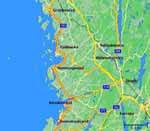 started towards Hamburgsund, where we made a
stop on the quay-side, at the mooring site of a ferry bound for a little island.
There is in fact a strait between the land and the island, some 80 m wide,
through which many sailing boats and motor boats pass in either direction, and
every so often all traffic stops and one has to wait for the ferry to cross from
one shore to the other. The ferry is hauled over the strait by means of a steel
wire cable by electric winch and, when it docks at one side, the cable is
slacked and falls to the bottom, so that the boats, which were gathered on both
sides, can start passing through the strait. The ferry travels continuously in
both directions, without any time table, it departs when full, or when there are
too many cars on the other side and they need to be ferried over. We found an
excellent parking place, a little elevated, at a distance of some 40 metres from
the strait, so we had our restaurant window facing the strait and the overview
of the whole crowd. Carla had cooked a nice, nice indeed soup of the upper half
of the torsk (including the head) and, accompanied by a nice wine and the
panoramic view of the strait traffic spectacle, the lunch was a full hit.
started towards Hamburgsund, where we made a
stop on the quay-side, at the mooring site of a ferry bound for a little island.
There is in fact a strait between the land and the island, some 80 m wide,
through which many sailing boats and motor boats pass in either direction, and
every so often all traffic stops and one has to wait for the ferry to cross from
one shore to the other. The ferry is hauled over the strait by means of a steel
wire cable by electric winch and, when it docks at one side, the cable is
slacked and falls to the bottom, so that the boats, which were gathered on both
sides, can start passing through the strait. The ferry travels continuously in
both directions, without any time table, it departs when full, or when there are
too many cars on the other side and they need to be ferried over. We found an
excellent parking place, a little elevated, at a distance of some 40 metres from
the strait, so we had our restaurant window facing the strait and the overview
of the whole crowd. Carla had cooked a nice, nice indeed soup of the upper half
of the torsk (including the head) and, accompanied by a nice wine and the
panoramic view of the strait traffic spectacle, the lunch was a full hit.
After lunch, but at that time with sun, we headed for fishing on the island situated about three km behind Hunnebostrand. The road leads over a turn bridge (+) situated at more than 10 m above the sea level and connecting the island to the mainland. Between the island and the mainland there is a 4-5 km long narrow channel. At the bridge the channel is about 30 m wide. When sailing boats pass, the bridge has to be turned for 900, whereas to let the cars over it is to be put in closed position again. There are always queues, on both side of the bridge on the road and on both water sides of the bridge in the channel. It was so at least that day. And when the bridge is turned to let the vessels pass, the spectacle is created again. All vessels, in two rows, one towards north and one towards south, pass in a disciplined manner, whereas we, from above approx. 20 m, were watching the show of yachts and crews. Very nice! A rather big passenger ship passed, too.
We crossed the bridge and
after approximately 2 km we arrived into a small place and started to fish from
the quay wall (++). It looked ideally, but
again without a tug. The only tug that was felt by Carla, when she, in her
fervour, waved the rod strongly, was the one when she caught by the blinker her
own hip, more precisely the upper hind part of it. Two sharp points of hooks
from the blinker (there are three in total, made in one tricorn) entered the
flesh deeply and actually with the hook non-return top, so that we were not able
to pull them out. We had to return to the camper and cut by pliers the end parts
of both hooks free from the tricorn. Carla pressed her teeth and I pushed, one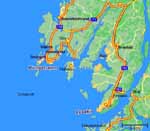 by one, the point of the hook forward until it had pierced the skin again and
came out, when I was able to pull them out with pliers.
by one, the point of the hook forward until it had pierced the skin again and
came out, when I was able to pull them out with pliers.
Carla was not especially impressed by events and the pains, so we went again to fish, that time from the rocks outside the settlement. We were fishing more than an hour, ideal position, again on a strait (300 m), but again not a single tug. When fishing, we met two guys, two Muslims from Sandžak¹), who had emigrated from Montenegro two years ago in order to avoid the service in Yugoslav Army. They were still jobless and were receiving assistance. One was a turner. They blamed Milošević for everything.
After the fishing, i.e. nothing-fishing respectively, we continued over Kungshamn and, in vicinity of the place Örn, descended again to the sea shore next to a docking site for Malmön. Also there, the ferry was being hauled over by means of a steel wire cable, but the distance to the island is there 700-800 metres! We threw the blinkers again and again not a tug. After that, we started to the north with the 171 and turned towards south by the 162 for Brastad and Lysekil at the place of Hallind, but we were not allowed into the town since there was a local feast and the town was closed for traffic. We returned onto the 161 and turned into Finnsbo and crossed by a ferry (free of charge – socialistic Sweden!) to Skår and after that, after 1 km, turned again to south for Fiskebäckskil. It’s a hamlet with a huge marina, where we parked at about 10.00 o’clock p.m. Carla fried the rest of the torsk and about 11.30 p.m. we moved into bed. The weather was still nice.
______________________
¹) Small southern region of Serbia close to Montenegro; Turkish for flag and military outpost.
The 41st Day – 15.07.1995 - Saturday: Fiskerbäckskil (S) - Skärhamn (S) – 131/10.913 km
The morning was cloudy with a breeze, but
without rain and without promising anything extraordinary. After breakfast we
climbed a small elevation over the place from where we had a splendid view
towards
Lysekil.
We moved on at about 10.30
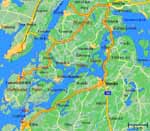 a.m.,
but after a short ride we stopped at a farm growing strawberries and went for
picking. The farm is entered with plastic containers that are weighed and their
weights marked on them. We paid the picked up strawberries SKr22 /kilo
(about 5.400 Italian lira/kilo), but in
turn you can eat at will during the picking. We had picked up 3 kilos of
wonderful big strawberries, but how many were in our stomachs only the God
knows. Two days thereafter we could not even look at them.
a.m.,
but after a short ride we stopped at a farm growing strawberries and went for
picking. The farm is entered with plastic containers that are weighed and their
weights marked on them. We paid the picked up strawberries SKr22 /kilo
(about 5.400 Italian lira/kilo), but in
turn you can eat at will during the picking. We had picked up 3 kilos of
wonderful big strawberries, but how many were in our stomachs only the God
knows. Two days thereafter we could not even look at them.
A little further we turned
away towards the fjord, in the place of Hällebäck
(a couple
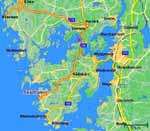 of
houses), to fish. Splendid rocks, a wonderful clean sea, I “bathed” the blinker
for long time, but not a tug again. Carla
did not fish, she tried to sun bake her on the rocks. We continued through
Overby and Henån,
where we turned off for Ellös, continuing on
through Stocken and
Varekil, up to the strait (+)
, where we parked on a parking lot by a bridge, and then descended down
the slope towards the strait. We tried again our luck, and again not a tug. Of
course! We did not wonder that those days we had not caught anything. Maybe, we
did not know how to fish? We wished that at least we might have felt a minimum
tug. Nothing! The Swedish fishes are really a sham!
of
houses), to fish. Splendid rocks, a wonderful clean sea, I “bathed” the blinker
for long time, but not a tug again. Carla
did not fish, she tried to sun bake her on the rocks. We continued through
Overby and Henån,
where we turned off for Ellös, continuing on
through Stocken and
Varekil, up to the strait (+)
, where we parked on a parking lot by a bridge, and then descended down
the slope towards the strait. We tried again our luck, and again not a tug. Of
course! We did not wonder that those days we had not caught anything. Maybe, we
did not know how to fish? We wished that at least we might have felt a minimum
tug. Nothing! The Swedish fishes are really a sham!
We continued on and about 7.30 p.m. we reached the port of Skärhamn, parked on the quay-side and had for dinner nice Norwegian fishes from our freezer. We intended to buy some new ones the next day. A big training sailing ship with three masts was in the harbour. There is also a splendid big marina. Regrettably, no fishing vessel could be seen. To prepare for sleeping, we moved off to a huge parking lot at the northern exit from the place, it was quiet and peaceful. At 10.45 p.m. we went to bed!
The 42nd Day – 16.07.1995 - Sunday: Skärhamn (S) - Hjuvik (S) – 147/ 11.060 km
We
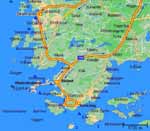 woke
up realising that the weather was nice, but actually we were awoken by a crow,
or perhaps a seagull, that was walking over our roof and was squawking. I hit
the roof from underneath two times with the fist and with the “shoo, shoo” it
flew away, but so did our sleep, too.
woke
up realising that the weather was nice, but actually we were awoken by a crow,
or perhaps a seagull, that was walking over our roof and was squawking. I hit
the roof from underneath two times with the fist and with the “shoo, shoo” it
flew away, but so did our sleep, too.
We departed at 10.15 a.m., entered Rönnäng, but it was not to our liking, so we returned to Bleket and parked in front of the amazing bridge for the island and the place of Klädesholmen. Nice view from the parking lot, in a glorious day, of a mass of small islands, like in Kornati¹), however more compact, more closed, so that there are no waves, but plenty of good wind. That’s ideal for sailing and gliding. Quite a number of sailing boats and motor boats were at sea. A nice marina with the gas station was under the bridge.
I descended to the sea and tried again with the blinker but again with the same result. Not a tug! While I was bathing the blinker, Carla had picked up two full containers of marvellous raspberries on the hill that descends from the bridge to the sea.
After this, we started for
Myggenäs, Jörland
and Marstrand. We stopped there under the
bridge for the island and enjoyed again the nice view of the sea and small
islands. There, we had fried frankfurters and potato salad with mustard and bee r
for lunch, and afterwards the raspberries with yoghurt. All around us was
crowded with people, being the Sunday that day, but after lunch an unearthly
hour came with quite a shower, so that everybody flew helter-skelter. When the
rain stopped and the high tide arrived, Carla and I we tried again to
r
for lunch, and afterwards the raspberries with yoghurt. All around us was
crowded with people, being the Sunday that day, but after lunch an unearthly
hour came with quite a shower, so that everybody flew helter-skelter. When the
rain stopped and the high tide arrived, Carla and I we tried again to
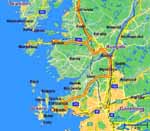 fish
from the quay-side under the bridge, but with the same result as before.
fish
from the quay-side under the bridge, but with the same result as before.
We moved on, again with nice weather, by the motor way for Göteborg via Kungälv, but after a while we turned off the motor way towards the airport and arrived to Hjuvik via Torslanda, where, at the end of the road, we parked in front of a small wharf and slept overnight. We made a call to Sabina in København and confirmed our arrival. Our dinner: nice pasta with dry beans! After this, fishing, just to repeat the negative result. And the bay was marvellous with all preconditions for fishing. Not a tug! I am bored to write always just the same thing, but to do it is even worse. Weather was nice, the night very quiet.
________________
¹) A well known archipelago in Dalmatia, Croatia
The 43rd Day – 17.07.95 - Monday: Hjuvik (S) - Glommen (S) – 143/11.203 km
Ships’ sirens awoke us early in the morning. Dense fog! After that a light rain started to drizzle, but when we awoke again, the sun was shining. At about 11.00 a.m. we started to Göteborg, parked our camper on one of the many parking lots long the quay-side and commenced to tour the town. It’s a nice town, but nothing special. We visited the harbour displaying wonderful ships, bought a salmon for Werner and had a hasty lunch finishing the remainders of the dinner (pasta and dry beans) and a bit of fruit.
We star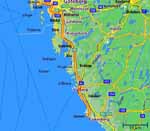 ted
at 2.30 p.m. by the motorway towards south, via
Mölndal, and arrived to
Varberg with
ted
at 2.30 p.m. by the motorway towards south, via
Mölndal, and arrived to
Varberg with
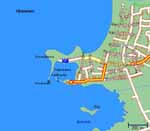 the
sun. We parked there on the quay-side, again with a great view, had
coffee, and afterwards we went to a camp and parked our camper at the
entrance to the camp. We walked into the camp, went under the showers
actuated by chips, had shower and washed our hair. Afterwards we moved
on and, according to the road sign “Glommen fiskehavn”, arrived
to Glommen, found a beautiful little
fishing port and, at the top of the quay-side, set our camp. Right away
next to us a lot of gorgeous sailing boats inside a little marina and
fishing vessels moored to the quay. Glorious sunny weather, but with a
strong wind from sea, that was hurling strong waves at the breakwater.
It was rather chilly. I had even desisted of the idea of fishing, it was
apparently the last opportunity to bathe the blinker. We were supposed
to board the ferry for Denmark the next day, which meant it was over
with fishing. Carla prepared the pasta sciutta alla bolognese with
salads, followed by strawberries, for the evening meal, all this
accompanied with wine, whereas we had celebrated the sunset behind the
clouds, at about 9.30 p.m., with champagne. We hoped to buy some fresh
fish the next day.
the
sun. We parked there on the quay-side, again with a great view, had
coffee, and afterwards we went to a camp and parked our camper at the
entrance to the camp. We walked into the camp, went under the showers
actuated by chips, had shower and washed our hair. Afterwards we moved
on and, according to the road sign “Glommen fiskehavn”, arrived
to Glommen, found a beautiful little
fishing port and, at the top of the quay-side, set our camp. Right away
next to us a lot of gorgeous sailing boats inside a little marina and
fishing vessels moored to the quay. Glorious sunny weather, but with a
strong wind from sea, that was hurling strong waves at the breakwater.
It was rather chilly. I had even desisted of the idea of fishing, it was
apparently the last opportunity to bathe the blinker. We were supposed
to board the ferry for Denmark the next day, which meant it was over
with fishing. Carla prepared the pasta sciutta alla bolognese with
salads, followed by strawberries, for the evening meal, all this
accompanied with wine, whereas we had celebrated the sunset behind the
clouds, at about 9.30 p.m., with champagne. We hoped to buy some fresh
fish the next day.
At 11.00 p.m. we were in beds, but a smaller tempest awoke us at night. For the first time in the 43 rather rainy days we have “heard” the transition of weather from dry to wet, accompanied by thundering and storming. The change of weather from the nice one to a shower was never accompanied by wind and lightning bolts in Norway. It used to be always either a gradual or an abrupt transition, but without acoustic or light effects. And, finally there were lightning bolts and thundering, as on our dear Adriatic.
Again, we fell asleep, our roof has gone also through worse stormy weathers.
The 44th Day – 18.07.1995 - Tuesday: Glommen (S) - Taastrup (DK) – 218/11.421 km
In the
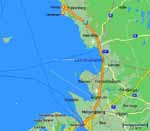 morning,
when we got up, the sun shone and a rather strong south-west wind was
blowing, but it was not cold. Two fishing vessels, too, reached the
harbour soon, accompanied by a huge flock of seagulls. Carla went right
away to the quay-side and bought a big mackerel and a sole, and she
bought
morning,
when we got up, the sun shone and a rather strong south-west wind was
blowing, but it was not cold. Two fishing vessels, too, reached the
harbour soon, accompanied by a huge flock of seagulls. Carla went right
away to the quay-side and bought a big mackerel and a sole, and she
bought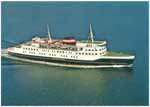 also a big cod additionally.
also a big cod additionally.
At about 11.00 a.m.
we departed finally towards the motor way which we entered at the place
of Morup, took the direction for
Helsingborg and from there proceeded directly for the ferry port, where
we arrived at about 1.10 p.m. With no delay we started queuing for
getting aboard, paid out of the camper the combined fare for the
Helsingborg - Helsingør
(Sweden - Denmark) and Rødbyhavn - Puttgarden (Denmark - Germany,
see the 46th Day) ferries and, after waiting of some 10
minutes, we were aboard the ferry. The Prinsesse Elisabeth sailed
off from the harbour of Helsingborg
(S) at 1.40 p.m. and at 2.25 p.m. we docked in
Helsingør
(DK). Boarding the ferry and disembarking from her passed without any
passport and customs control. On the shore in Helsingør,
there was a rather long queue of cars and many campers and trailers
waiting to get aboard. The traffic towards the north was considerably
more intense than that towa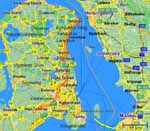 rds
south and the process of getting
aboard the ferry was not as fast as was ours in Helsingborg.
rds
south and the process of getting
aboard the ferry was not as fast as was ours in Helsingborg.
We started from Helsingør with sun by the coastal road to København and stopped in the place Humlebæk, right next to the beach. Carla fried the mackerel and the sole and the lunch passed with a great view of the sea, sailing boats, beach and swimmers. During the lunch a small tempest occurred, bringing strong wind, but no rain. Some sailing boats and surfers had some problems, but all passed relatively quickly.
After lunch, with sun again, we continued our trip via Usserød, where we made a stop to buy necessary packages for our friends in København. After that we entered the motor way and about 6.30 p.m. we arrived to Taastrup, to Sabina and Oskar. We parked in front of their house situated in wonderful greenery, at some 20 km away from København. Both daughters, Tanja and Vibeke, were also at the dinner, and the talking lasted till after the midnight.
The night passed in marvellous silence.
The 45th Day – 19.07.1995 - Wednesday: København (DK) - 0/11.421 km
Oskar took Carla and
me in the morning by his car to København offering us some sightseeing
of the city. We visited the mon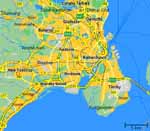 ument
to the siren, the symbol of København, thereafter the factory of the
Tuborg beer, in which he had worked for many years as an engineer (being
now retired) and at the end the offices in which Sabina was working.
Upon that, Oskar left us alone in the city and Carla and I went to tour
it. Very beautiful town, interesting, nice buildings, renovated and
painted facades, not much greenery, but a lot of water, channels and
seaside, the harbour is practically within the town centre. We had lunch
in the street in front of McDonald’s and watched a river of people
passing in front of our eyes. The streets looked like promenades, and in
squares, the youth was sitting on the pavement enjoying the sun, someone
was eating, someone was drinking, someone was playing music, drums,
performing dances, the break-dance as well. Everything was full of life
and no one bothered the other ones.
ument
to the siren, the symbol of København, thereafter the factory of the
Tuborg beer, in which he had worked for many years as an engineer (being
now retired) and at the end the offices in which Sabina was working.
Upon that, Oskar left us alone in the city and Carla and I went to tour
it. Very beautiful town, interesting, nice buildings, renovated and
painted facades, not much greenery, but a lot of water, channels and
seaside, the harbour is practically within the town centre. We had lunch
in the street in front of McDonald’s and watched a river of people
passing in front of our eyes. The streets looked like promenades, and in
squares, the youth was sitting on the pavement enjoying the sun, someone
was eating, someone was drinking, someone was playing music, drums,
performing dances, the break-dance as well. Everything was full of life
and no one bothered the other ones.
At 5.00 p.m. we met again Sabina, who showed us some further peculiarities of the town, and afterwards reached Taastrup by the underground and arrived home by bus.
We had dinner in the garden, smoked salmon and thereafter the barbeque, all this with nice Argentinean and French wine. Chatting again, but not until too late hours.
The 46th Day – 20.07.1995 - Thursday: Taastrup (DK) - Ebstorf (D) – 405/11.826 km
After having had breakfast together with Oskar, Sabrina was at that time in
the office already, we departed about 10.30 a.m. towards the south of
Denmark. We drew on the motor way E47, bypassing the places
Køge and
Rønnede, up to the beautiful bridge over
Storstrømmen, at which we made a stop,
but continued on nearly without delay, since the landscape was not to
our liking and the sea was too shallow to make the fishing possible. We
did not stop all up to Rødbyhavn,
where we arrived about 2.00 p.m. and where we spent first all the
remaining Danish small money. At 2.10 p.m. we boarded the ferry in
Rodbyhavn and at 3.00 p.m. we arrived into the port of
Puttgarden (D). During the crossing of
the sea the weather
having had breakfast together with Oskar, Sabrina was at that time in
the office already, we departed about 10.30 a.m. towards the south of
Denmark. We drew on the motor way E47, bypassing the places
Køge and
Rønnede, up to the beautiful bridge over
Storstrømmen, at which we made a stop,
but continued on nearly without delay, since the landscape was not to
our liking and the sea was too shallow to make the fishing possible. We
did not stop all up to Rødbyhavn,
where we arrived about 2.00 p.m. and where we spent first all the
remaining Danish small money. At 2.10 p.m. we boarded the ferry in
Rodbyhavn and at 3.00 p.m. we arrived into the port of
Puttgarden (D). During the crossing of
the sea the weather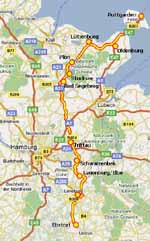 was fine, sunny with light mist.
was fine, sunny with light mist.
In Puttgarden, the German police had checked the passports at disembarkation, and, in fact, this was the only border control which we did experience on the whole journey from the departure from home till the return to San Maurizio. We had crossed borders 10 times, having 20 check points, but with this one and single check only!
We continued over the E47 for Oldenburg, turned there to the right onto the B202 for Lütjenburg and there onto the B430 for Plön situated within the National Park Naturpark Holzsteinische Schweiz¹). We continued surrounded by wonderful nature and lakes over the L68 and 432 for Stocksee and Bad Segeberg and further on over the A21 and B404 for Trittau and Schwarzenbek, then over the B209 for Lauenburg/Elbe, then with the K53 for Lüneburg and bypassed it over the 209, and arrived at about 8.00 p.m. over the L233 to Ebstorf. We did not want to ride over the motor way, we went again around not the shortest way, since Carla had wished that we would see a little of the Northern Germany, and that was why the journey took longer. The landscape is really beautiful, but under sun and with passages through inhabited place with lot of traffic it was rather hard and long lasting.
We stopped in Ebstorf and found a nice parking lot by the cemetery (practically in the centre of the place). At first we wanted to see this small town, but everything was already closed and the place was desolate. There was hardly anyone on the street, although it was still the daytime, and after an hour we returned to the camper. I started to feel a little dizzy, probably due to the driving in sun, I did not feel well, but an excellent idea crossed the mind of Carla, namely that the vodka is the best medicine, and so it was. The organism was brought finally in shape again by the dinner.
The night passed peacefully and quietly.
______________________
¹) Natural Park Switzerland of Holzstein
The 47th Day – 21.0719.95 - Friday: Ebstorf (D) - Steinberg (D) – 438/12.264 km
The sun awoke us in
the morning, but also the people who started to park cars. All of them
were nicely dressed and with black ties, so we realised that probably a
funeral would take place. We hastily had our breakfast and cleared away
from the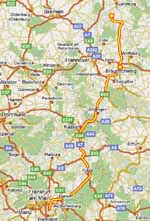 parking lot already at 9.15 a.m. We took the direction towards the south
with the L250, the way led us through a beautiful forest and there we
turned away from the asphalt and entered the wood. We parked at some
100m from the road in a wonderful shadow and relative quietness. We
performed first our morning body washing routine and then, Carla took
the opportunity, seized the scissors and the comb and brought my head a
bit in order. My head was rather overgrown by the hair. I had no hair
cut for two months.
parking lot already at 9.15 a.m. We took the direction towards the south
with the L250, the way led us through a beautiful forest and there we
turned away from the asphalt and entered the wood. We parked at some
100m from the road in a wonderful shadow and relative quietness. We
performed first our morning body washing routine and then, Carla took
the opportunity, seized the scissors and the comb and brought my head a
bit in order. My head was rather overgrown by the hair. I had no hair
cut for two months.
We continued thereafter the trip and passed through Uelzen and continued over the B4 for Braunschweig. There, we entered the motor way A39 and continued by the A7 via Göttingen and Kassel up to Fulda where, after the place Eichenzell, we came out from the motorway and turned for Frankfurt. The marvellous road B40 got transformed after some 30 km again into the nice motor way, we passed Steinau, Hanau and, at about 5.00p.m., we reached Steinberg.
We parked in a quiet side street, by the entrance to the wood, and went to make a call to Werner, who would have his birthday the next day. Carla’s parents, who came from Kempten, were already there. Chats and evening meal time, but, after the dinner, Carla’s mother suddenly became sick, probably due to the heat (370 C in shadow), which she, being an asthmatic patient, supports with difficulty, and besides, it appeared, that she had liked too much the evening meal and did not pay attention regarding the amount. Her blood pressure jumped to 200-105, but after an hour or so everything was back to normal. It was hot in the camper at night, the window facing the street we could not keep open to avoid that some high vehicle brings it off, and the one over the sidewalk cold cause a collision with the head of a passer by, We managed to sleep overnight and to remain alive.
The 48th Day – 22.07.1995 - Saturday: Steinberg (D) – 0/12.264 km
We congratulated Werner his birthday in the morning, and at noon we were his guests at lunch in a restaurant. Carla’s mother did not want to take chances and stayed at home. But it was Werner’s son Johann, together with Marina and Tobias, who came instead. Everybody abhorred when I decided to order a Vienna steak for lunch, but I preferred it to various fillets and stuffed cutlets. It was only Marina who took me in defence stating that, if properly made, this can be an excellent dish in such a case. At the end Tobias ordered the same. The steak was nevertheless very good, although something too thin in meat, and too abundant in its coating.
A light tempest started after the lunch turning soon into rain, causing a steep drop in temperature (to 200 C). One could breathe at last and one could sleep well again in the camper at night.
The 49th Day – 23.07.1995 - Sunday: Steinberg (D) - Birkenau NL (D) – 117/12.381 km
Th e
sun shone again in the morning, it was fresh and pleasant.
e
sun shone again in the morning, it was fresh and pleasant.
We took our leave of all after lunch and started again towards south. We reached Weinheim by the motor way A5 under nice, sunny and warm weather and continued for Birkenau-NL, where Ulla and Herbert were already expecting us. We intended to stay shortly only, an hour or two, to take our two gazebos for the camp, which they had procured for us in the meantime, (during our last visit, on 09.06., they were all sold out) and to proceed for Kappel in Switzerland right away. But we had made a bill without the host. We had to stay on their beautiful terrace, and at 7.00 p.m. Herbert took us to a restaurant with domestic cuisine and with an exquisite speciality: grilled hock (gegrillte Haxe). We drove to Heidelberg after the abundant evening meal and took a walk through the main street of the city. All full of people and of life, wonderful town, untouched by bombs. We were strolling till midnight and then returned to Herbert’s place and then went straight away to bed.
We parked like 45 days ago, on the road in front of the house. The night was pleasant for sleeping, but the great amount of meat in stomach did not act as a soporific. However, I survived that, too.
The 50th Day – 24.07.1995 - Monday: Birkenau NL (D) - Kappel (CH) – 350/12.731 km
A nice sunny day was born
and we spent the morning on the Ulla’s terrace, in sun. Herbert was on
his j ob,
but he came about 1.00 p.m. to the lunch, which was prepared by Carla.
It was the pasta al pommodoro. Apparently
they liked it very much.
ob,
but he came about 1.00 p.m. to the lunch, which was prepared by Carla.
It was the pasta al pommodoro. Apparently
they liked it very much.
We took leave about 3.00 p.m. and went for Mannheim, to a warehouse, to by some presents, and thereafter we started towards south, towards Switzerland. All the time with warm weather and, luckily, without crowded motor way, we finally reached Basel, and half an hour afterwards we arrived to Kappel, about 8.30 p.m. Only Dora was at home, Michelle’s mum. Davor had made a call, some while before our arrival, however from France, where all the family was still camping that week. He heard from Dora that we were coming, so he called again some time later, thus enabling me to converse over the phone with all four. The conversation with Dora lasted a bit longer, but about 11.30 p.m. we withdrew to the camper which was parked in front of the garage in the quiet Reckakerstraße.
The 51st Day – 25.07.1995 - Tuesday: Kappel (CH) - San Maurizio Canavese (I) – 430/13.161 km
We took our leave of Dora after breakfast at about 9.00 a.m. and started
the last leg of our long and, in spite of the rainy period in Norway,
very nice journey over Scandinavia.
took our leave of Dora after breakfast at about 9.00 a.m. and started
the last leg of our long and, in spite of the rainy period in Norway,
very nice journey over Scandinavia.
By the motorway via Lugano, Chiasso and Milano we arrived home in San Maurizio Canavese at nice weather, after 13.161 km (See the table) at about 2.00 p.m. Peter was at work, and Jasminka was trying to bring the house back to order after the celebration of her 23rd birthday.
We managed to put in time our dear camper, our second but nice home, under the roof, but not for long, as we were intending to go to the sea, in Istria, in our camping “FKK Kažela” in Medulin¹).
¹) Small place and resort at the south point of the Istrian peninsula, Croatia.